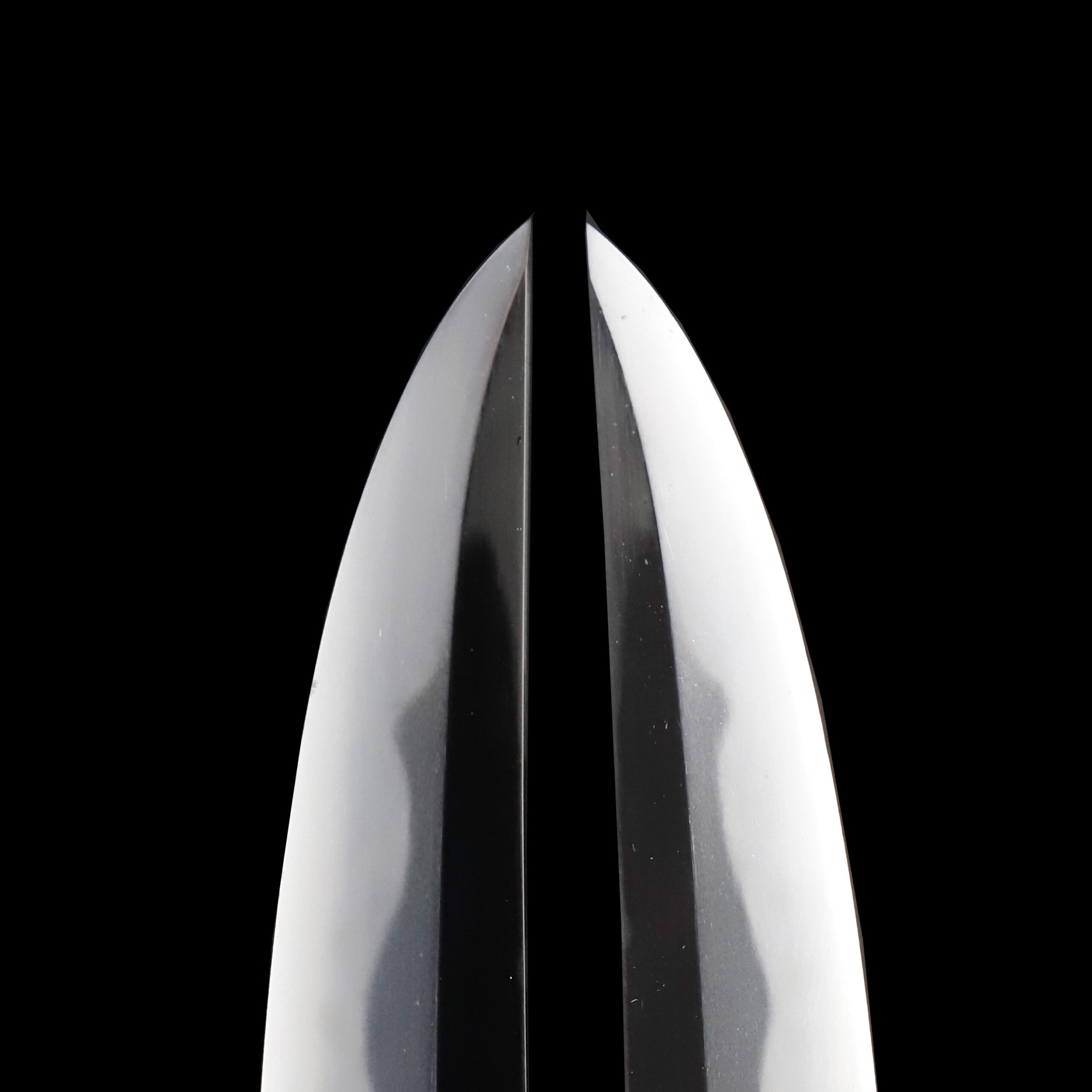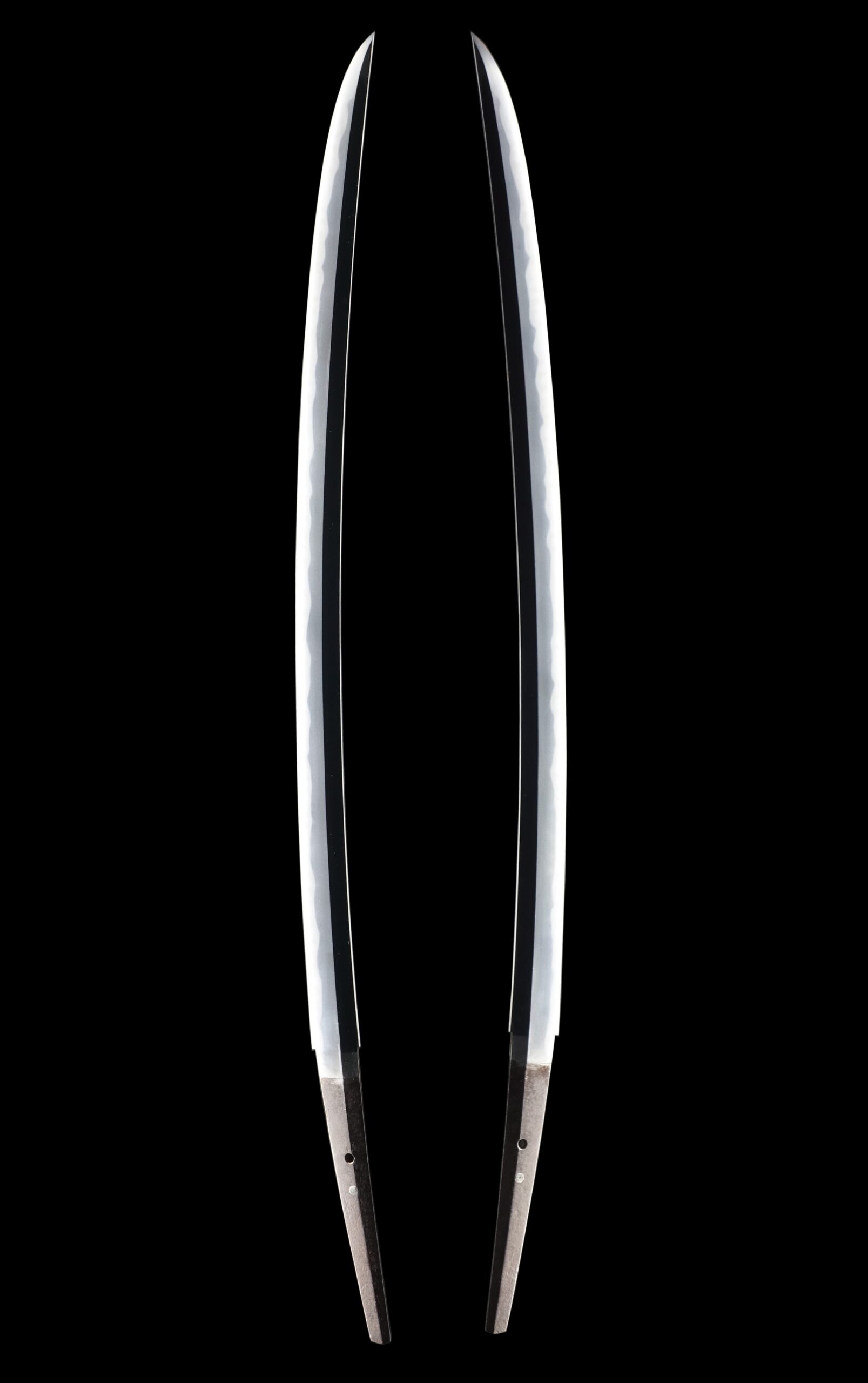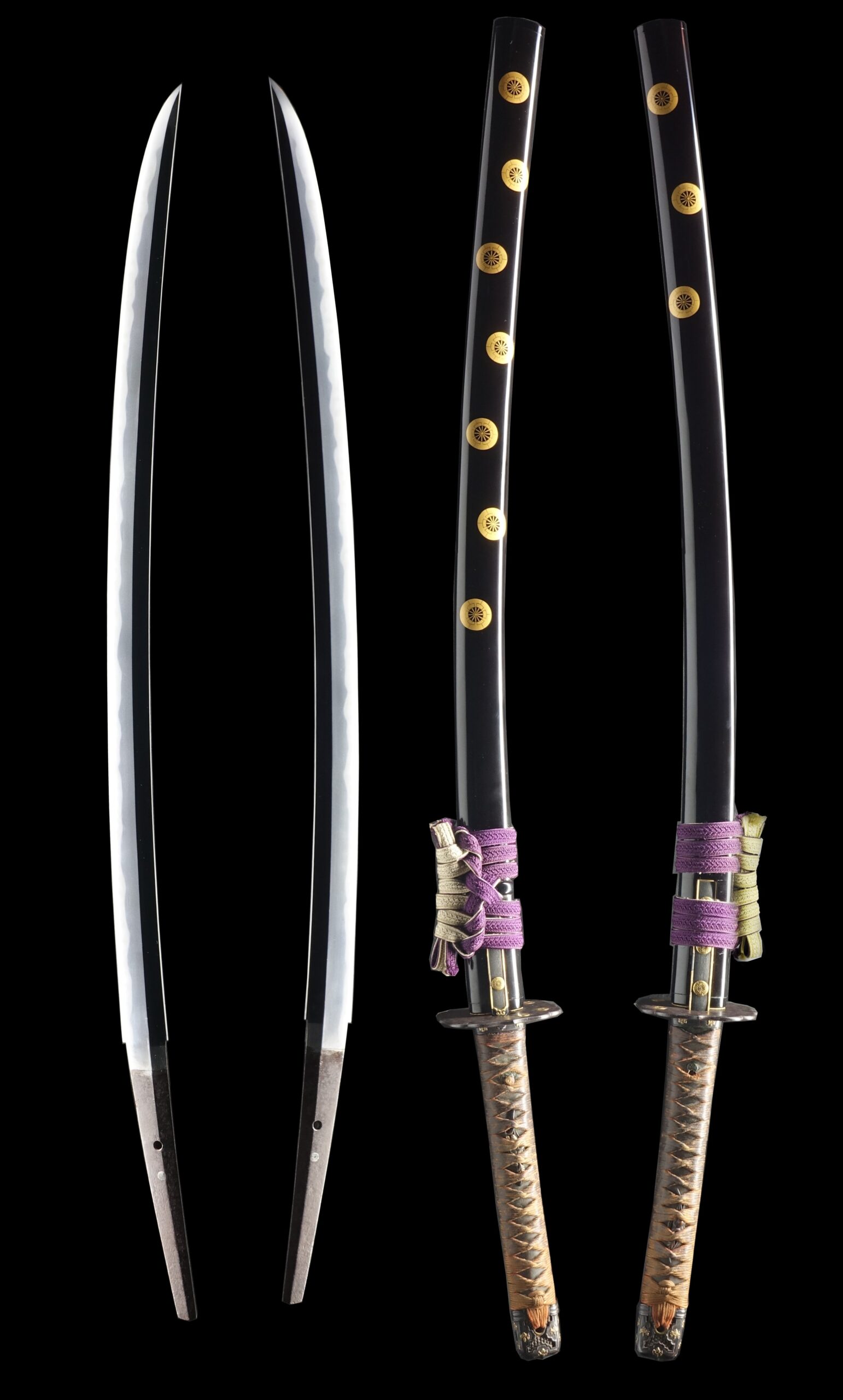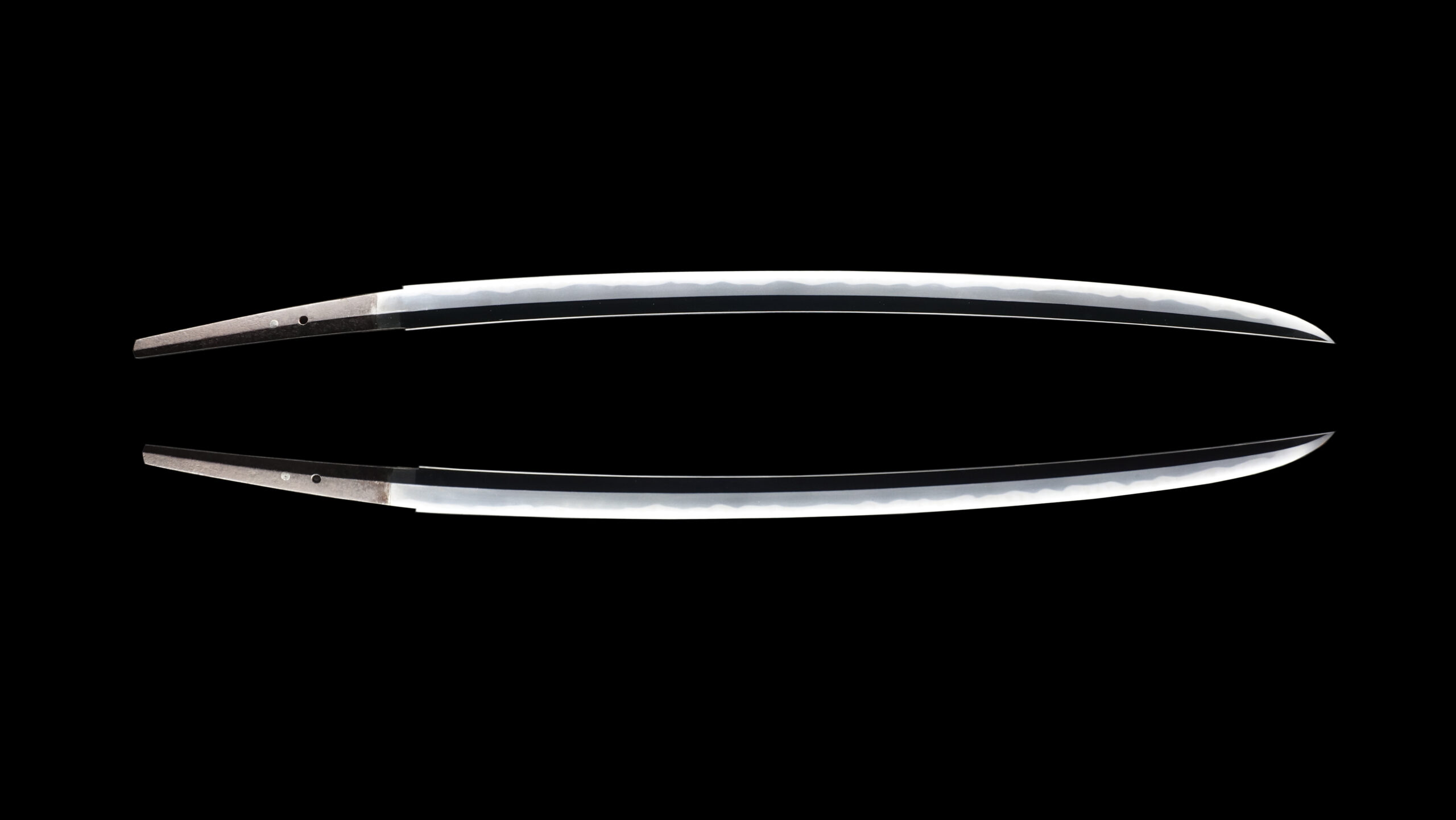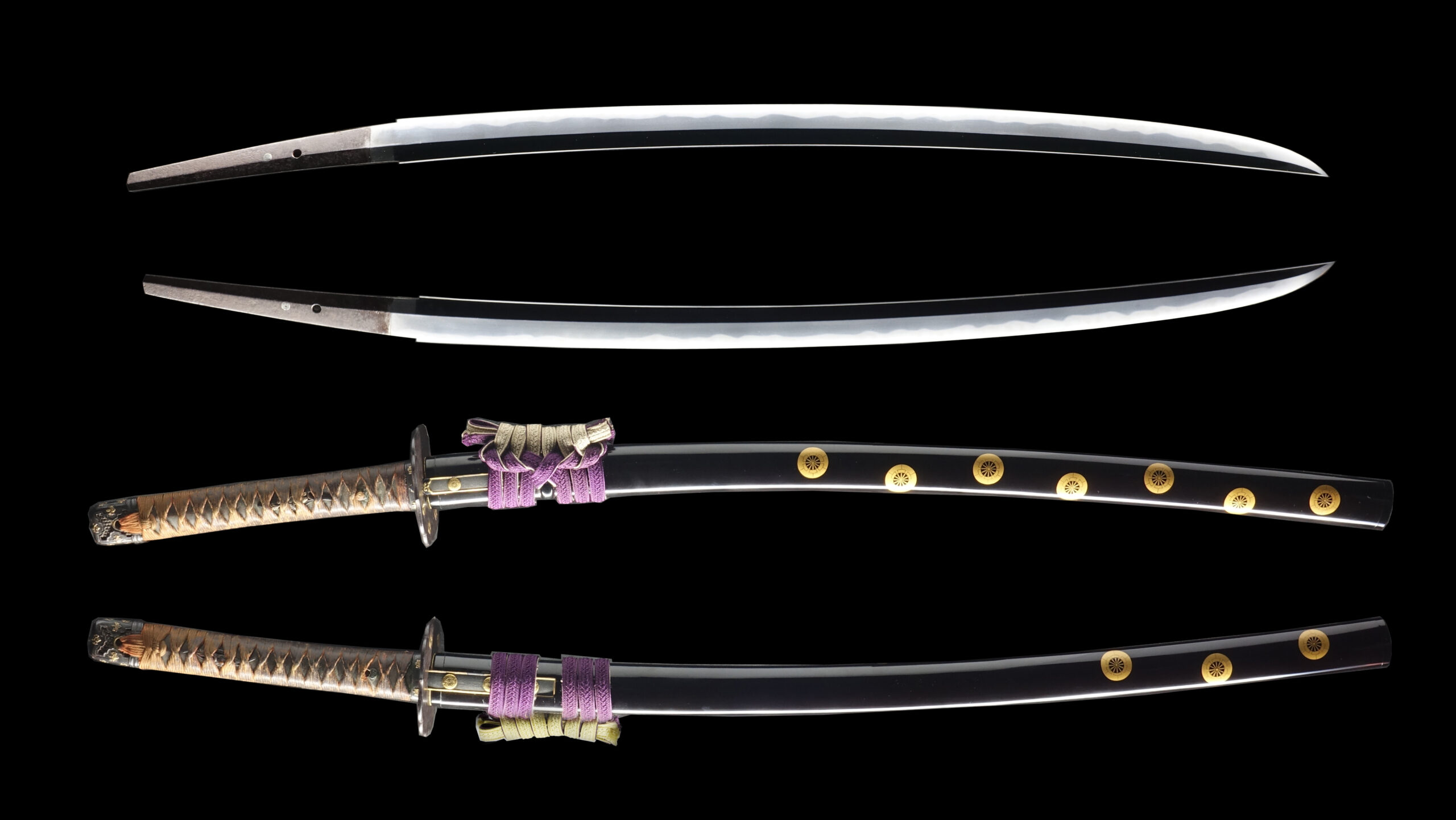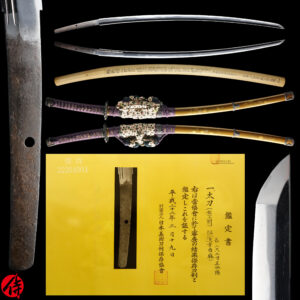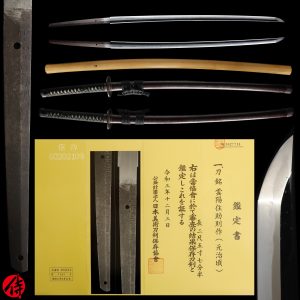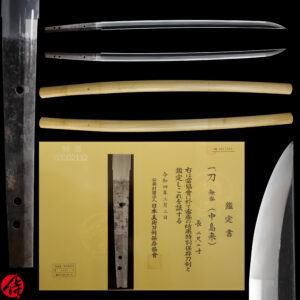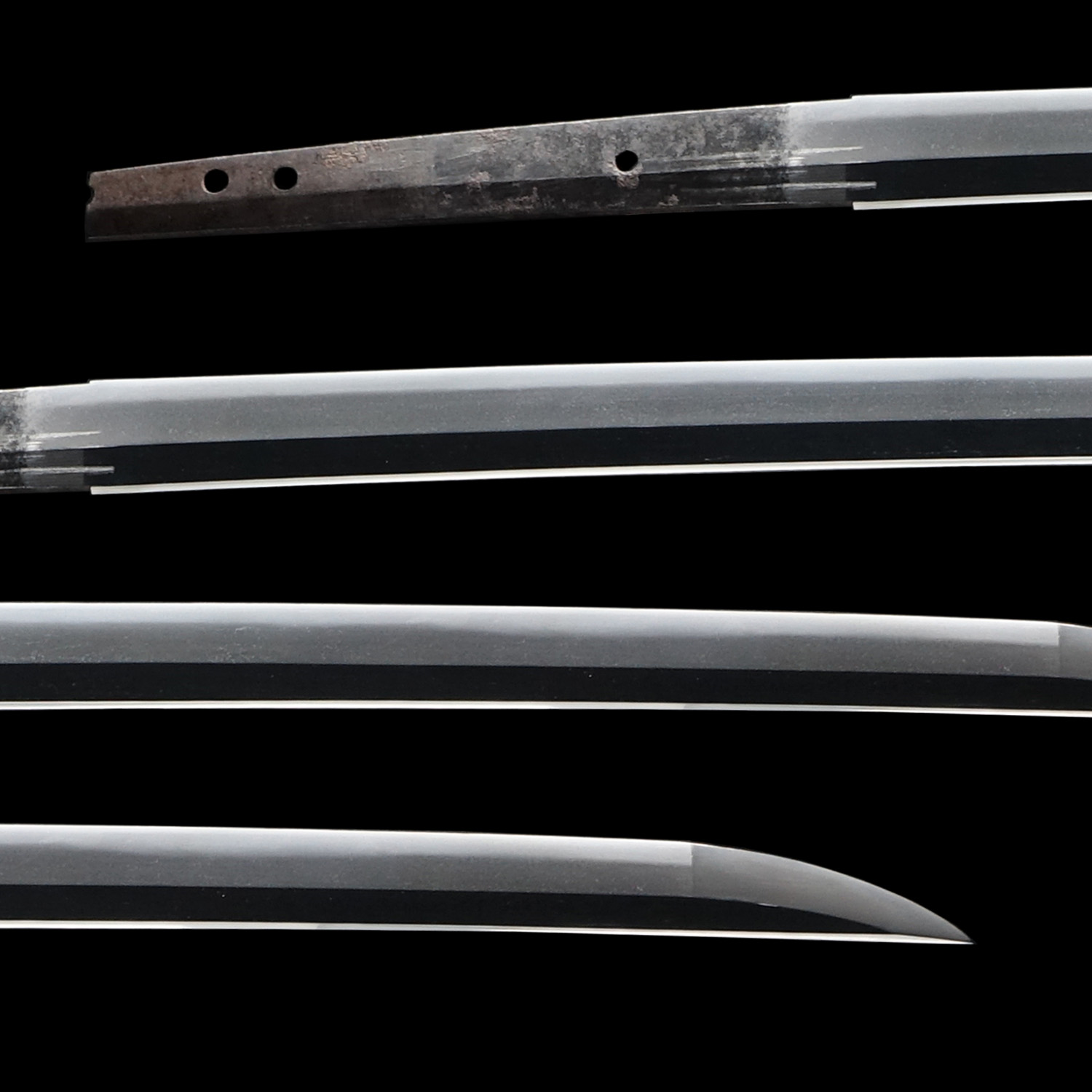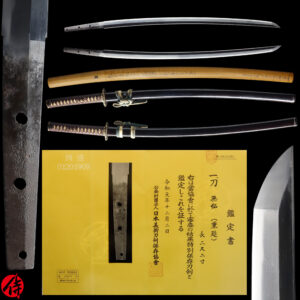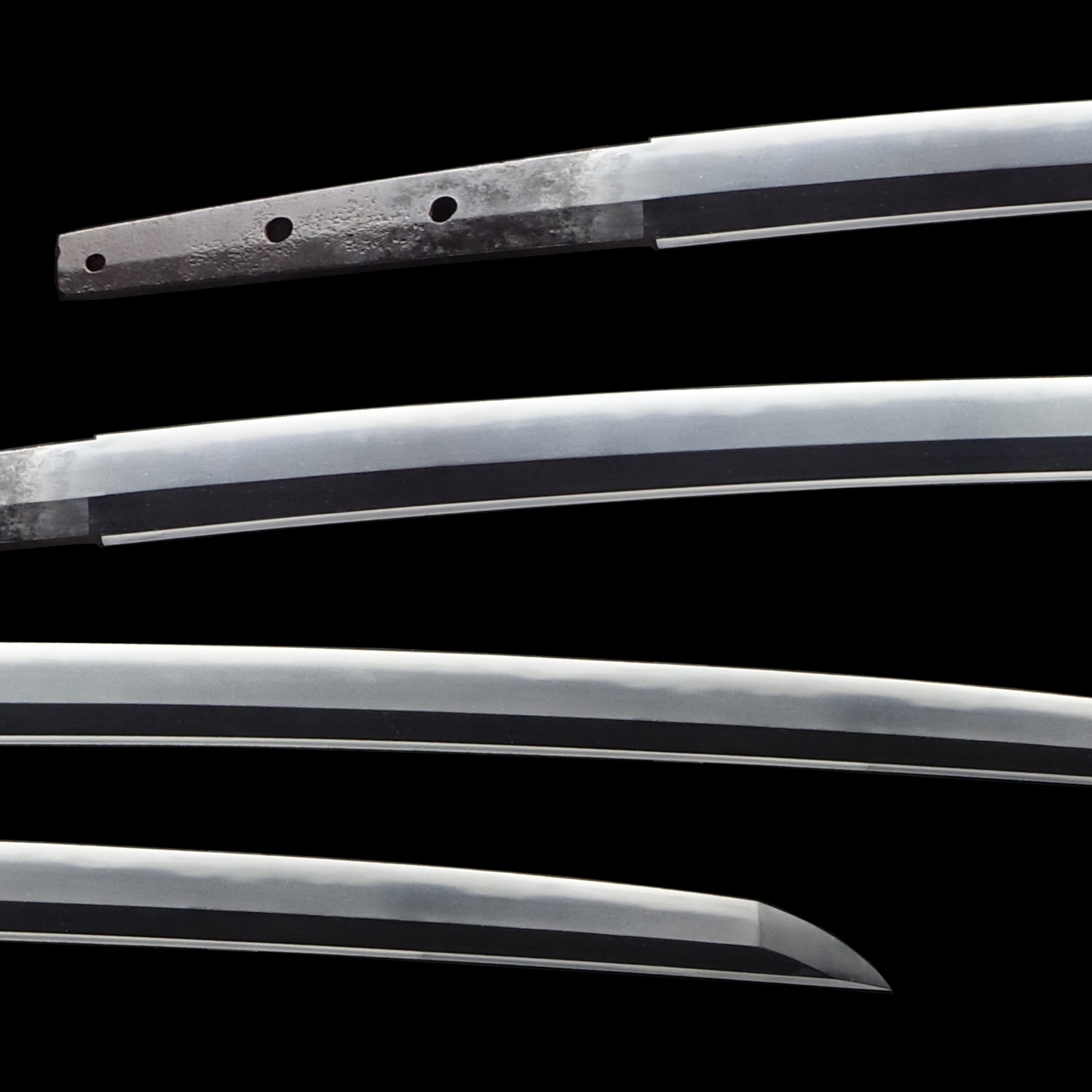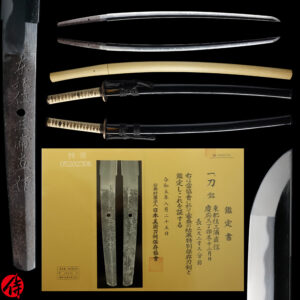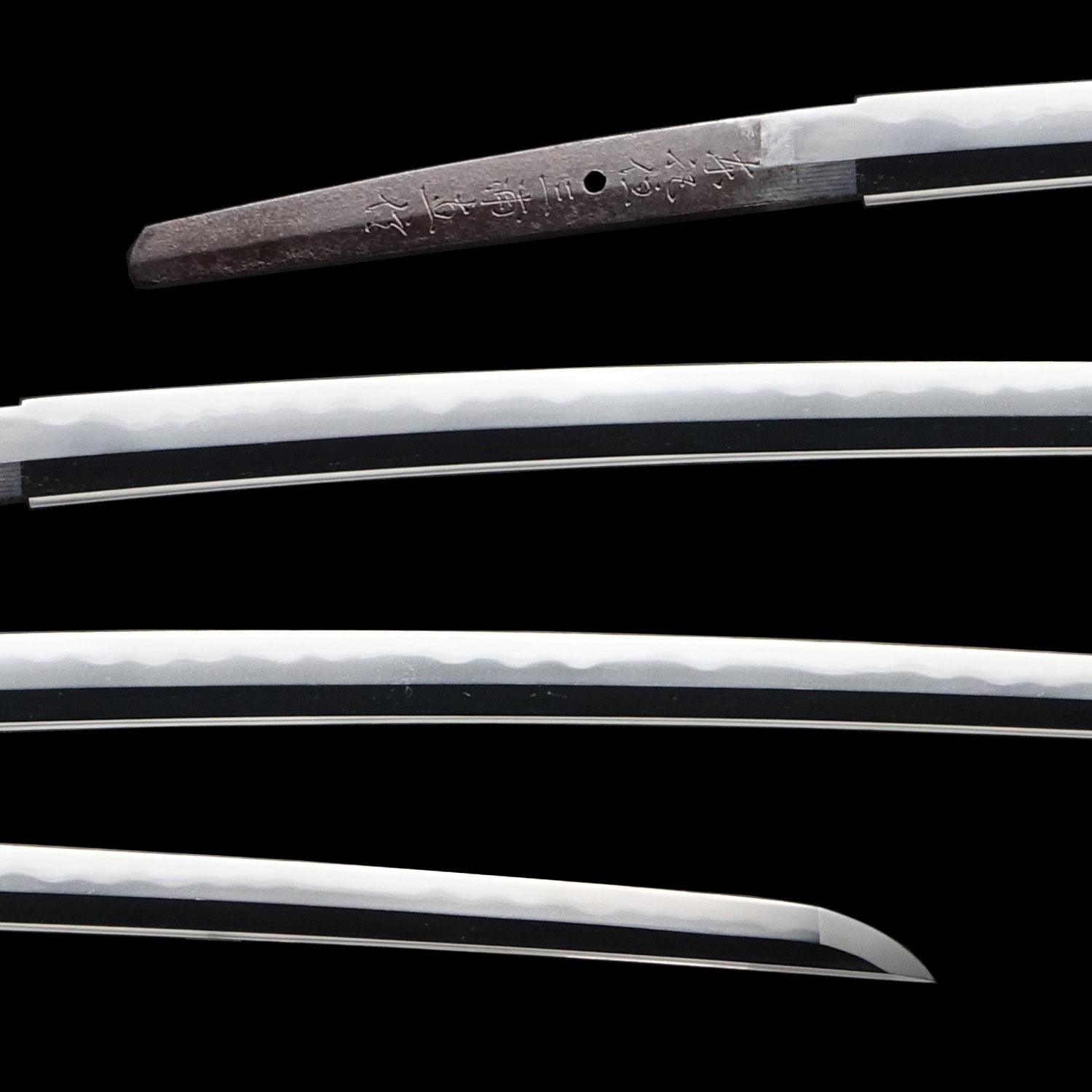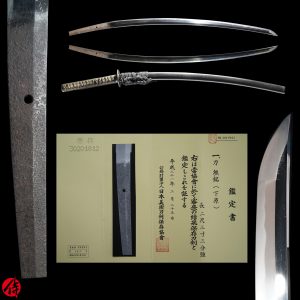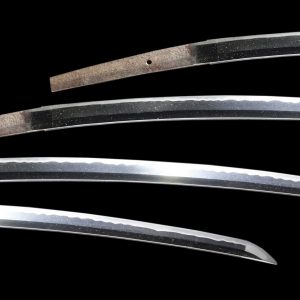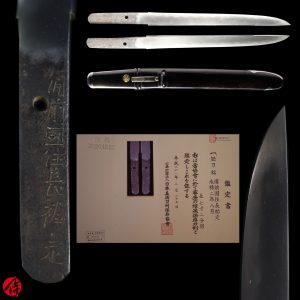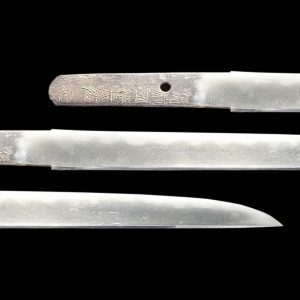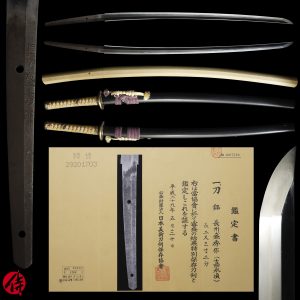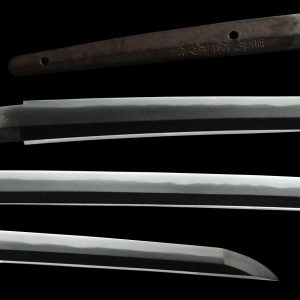Antique Japanese Sword Katana attributed to Koyama Munetsugu with NBTHK Hozon Certificate
【Description】
This blade is attributed to Koyama Munetsugu (固山宗次), who was active during the late Edo period (1830-1860). His birth name name Koyama Sobei (固山宗兵衛). He was born as the third son of Koyama Munehira(固山宗平) in Shirakawa domain in Mutsu province (today’s Fukushima prefecture) in 1802. It is said that he learned the sword-forging technique from Kato Tsunahide(加藤綱英) first and was also an apprentice of Chounsai Tsunatoshi (長運斎綱俊), a younger brother of Tsunahide to improve his craftsmanship.
Munetsugu first served Shirakawa Matsudaira(白河松平家) clan as Hanko(藩工:retained swordsmith). After Matsudaira clan was ordered to relocate to Kuwana domain(Today’s Mie prefecture), Munetsugu became a swordsmith for that domain. However, he eventually settled in Edo city from the second year of the Koka era (1845) by working for Matsudaira clan of the Kuwana family. Because of these historical records, we believe this blade was made in Edo city.
Munetsugu received an honorable title of Bizen no Suke(備前助) in the same year when he moved to Edo city(1845). His work reflects Bizen Den, one of the five most traditional Japanese sword-forging techniques (五箇伝). He was excellent at forging blades with Choji Gunome Midare tempering line, one of the most noticeable characteristics of Bizen Tradition. He was active in sword-forging during 1830-1870. He is arguably the finest smith working in the Bizen tradition at the end of the Edo period.
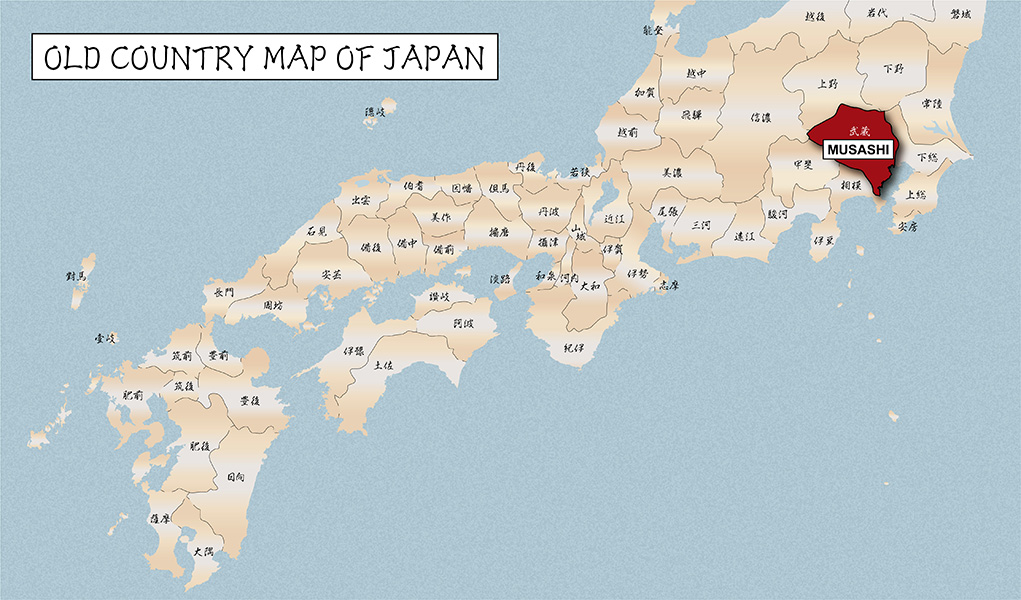
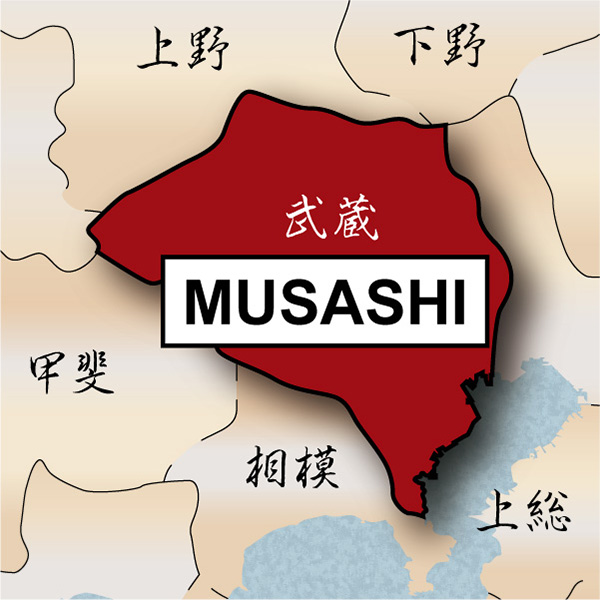
Munetsugu was one of the most popular and famous swordsmiths in Edo city during the end Edo period. His swords have been known for their sharpness. There are many records of his swords passing the test cutting process(Tameshigiri). In his career, he pursued and researched sword-forging to make extremely sharp blades that were practically effective in battles to meet up the demands of the clan. There was a record of him studying to improve the sharpness of his swords from the seventh-gen Yamada Asaemon, who is a master of Tameshigiri and an author of Owazamono. He often received orders from feudal lords or famous figures during the end of the Edo period. Munetsugu has been highly regarded among Japanese sword collectors and experts. It is said that his level of craftsmanship is close to or at least equivalent to Sushinshi Masahide, Naotane and other very selected swordsmiths from the end of the Edo period.
You can see interesting Kissaki (tip of the blade) called Shobu Zukuri (菖蒲造り). There is no Yokote on this blade. Yokote is the borderline between the tip and cutting edge. We are confident you will appreciate the elegant look of this blade.
This blade is appraised as a Hozon Touken (保存刀剣) issued by NBTHK (Nihon Bijutsu Touken Hozon Kyokai: 日本美術刀剣保存協会). This authentication paper was only given to authentic Japanese swords, well preserved and high quality with artistic value.
【Blade】
Cutting Edge Length (Nagasa): 60.6 cm ( 23.8 inches)
Curvature (Sori): 1.7 cm (0.67 inches)

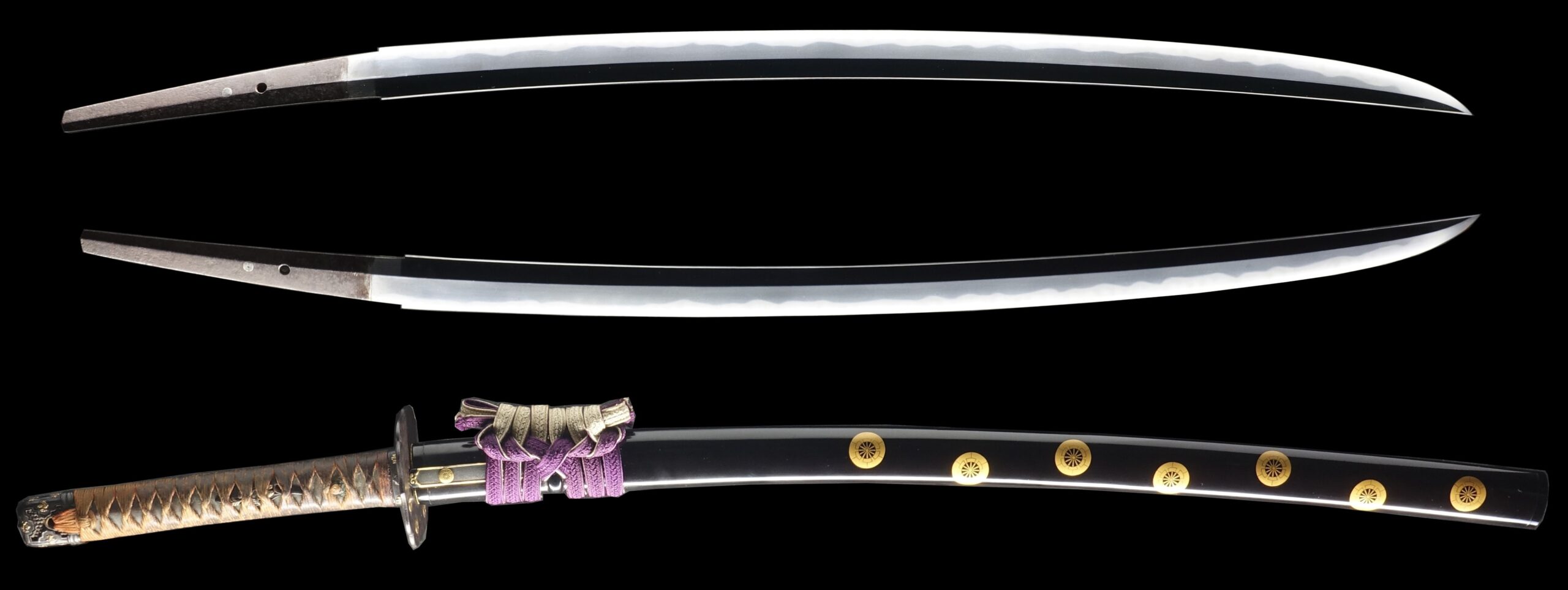
Hamon:
The crystalline structure which forms along the cutting edge of a blade as a result of the hardening process.
Jimon (Jihada):
Visible steel surface pattern created by folding and hammering during forging process.
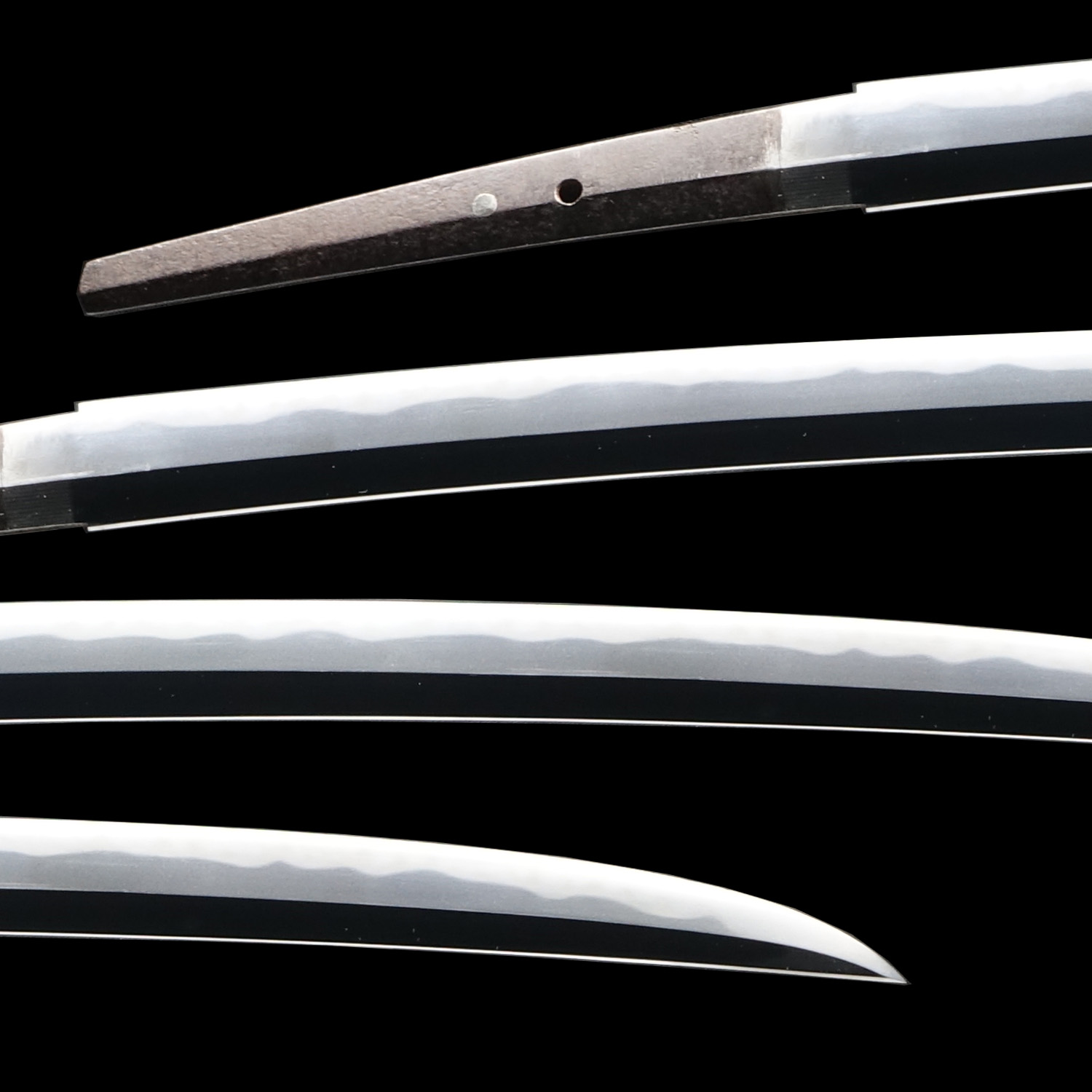
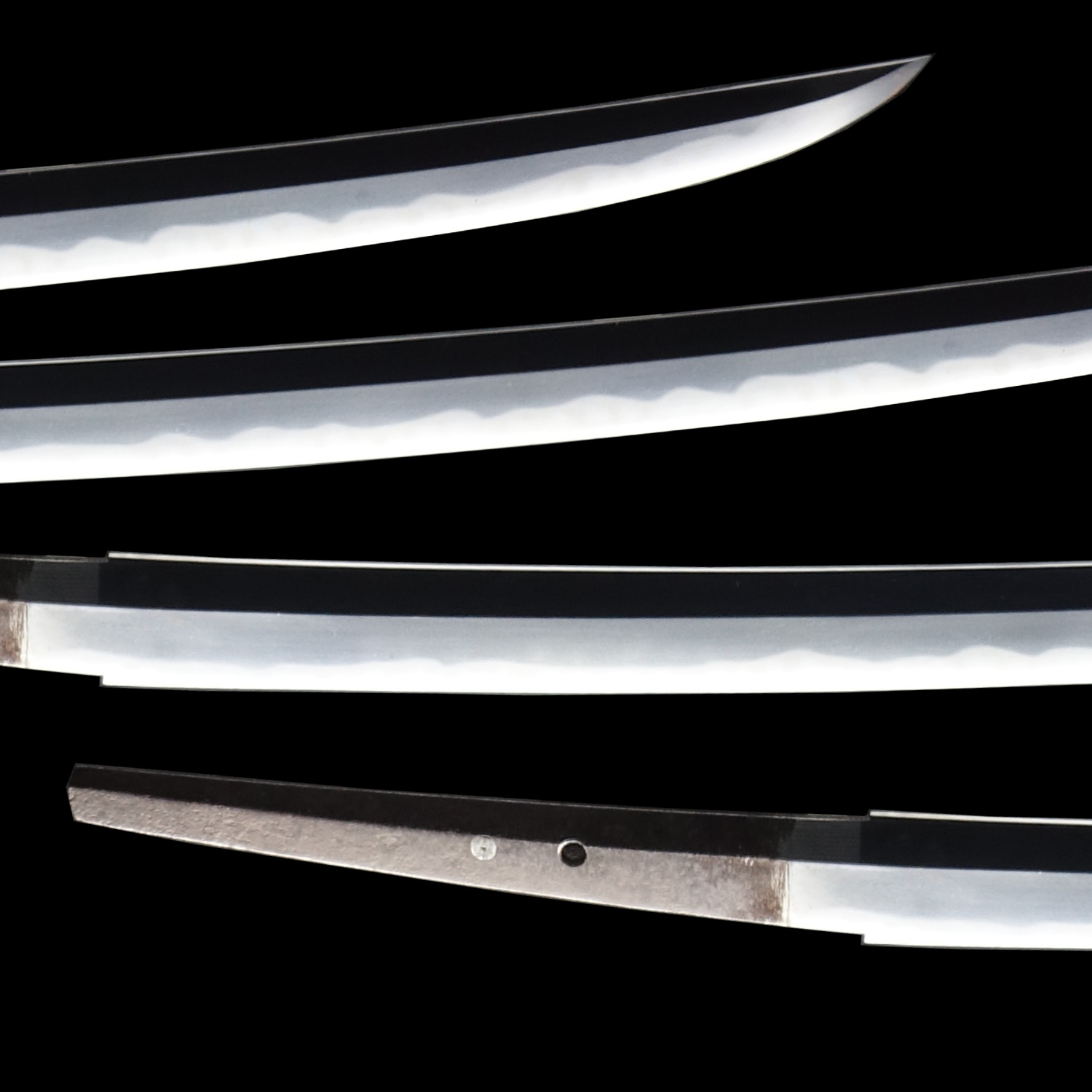
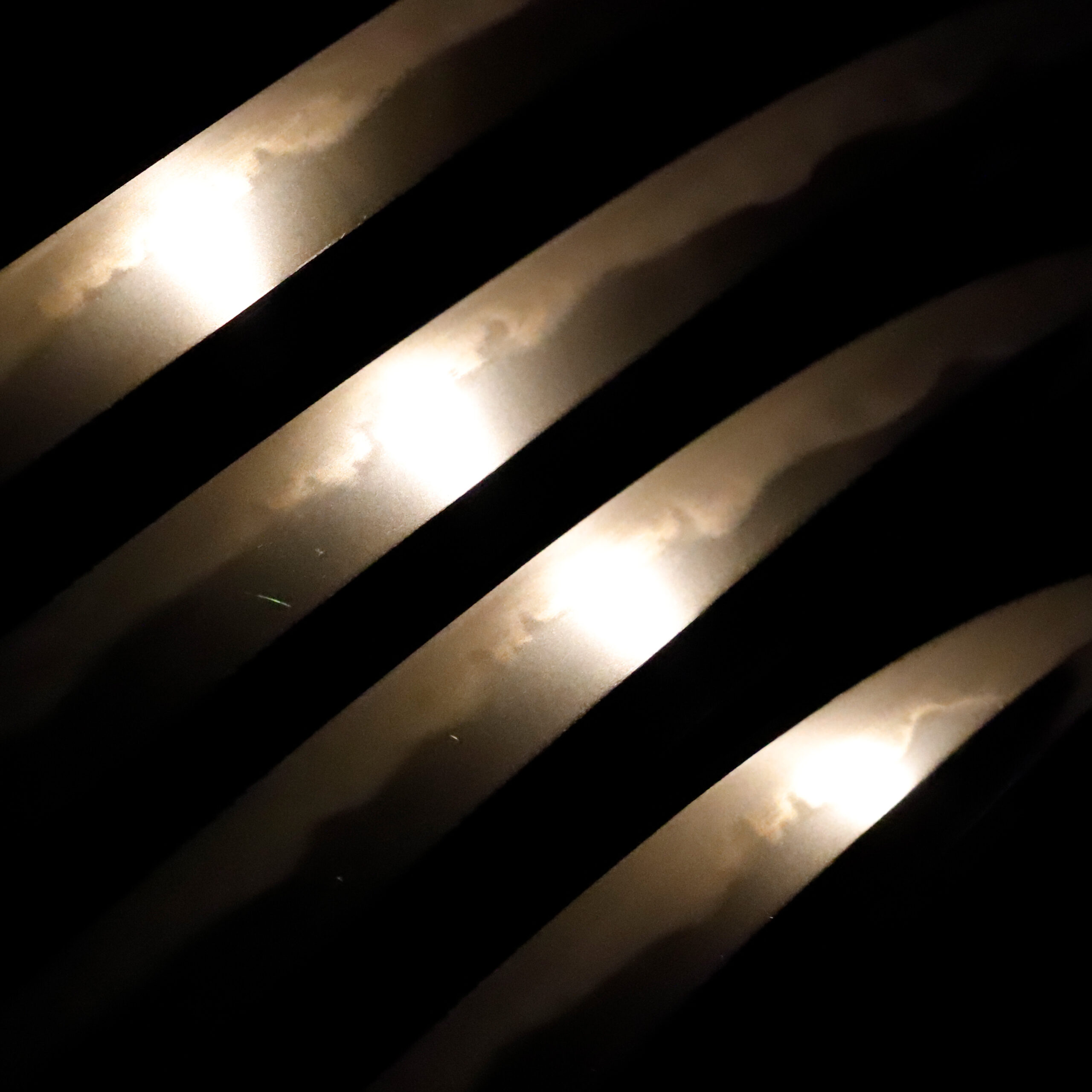

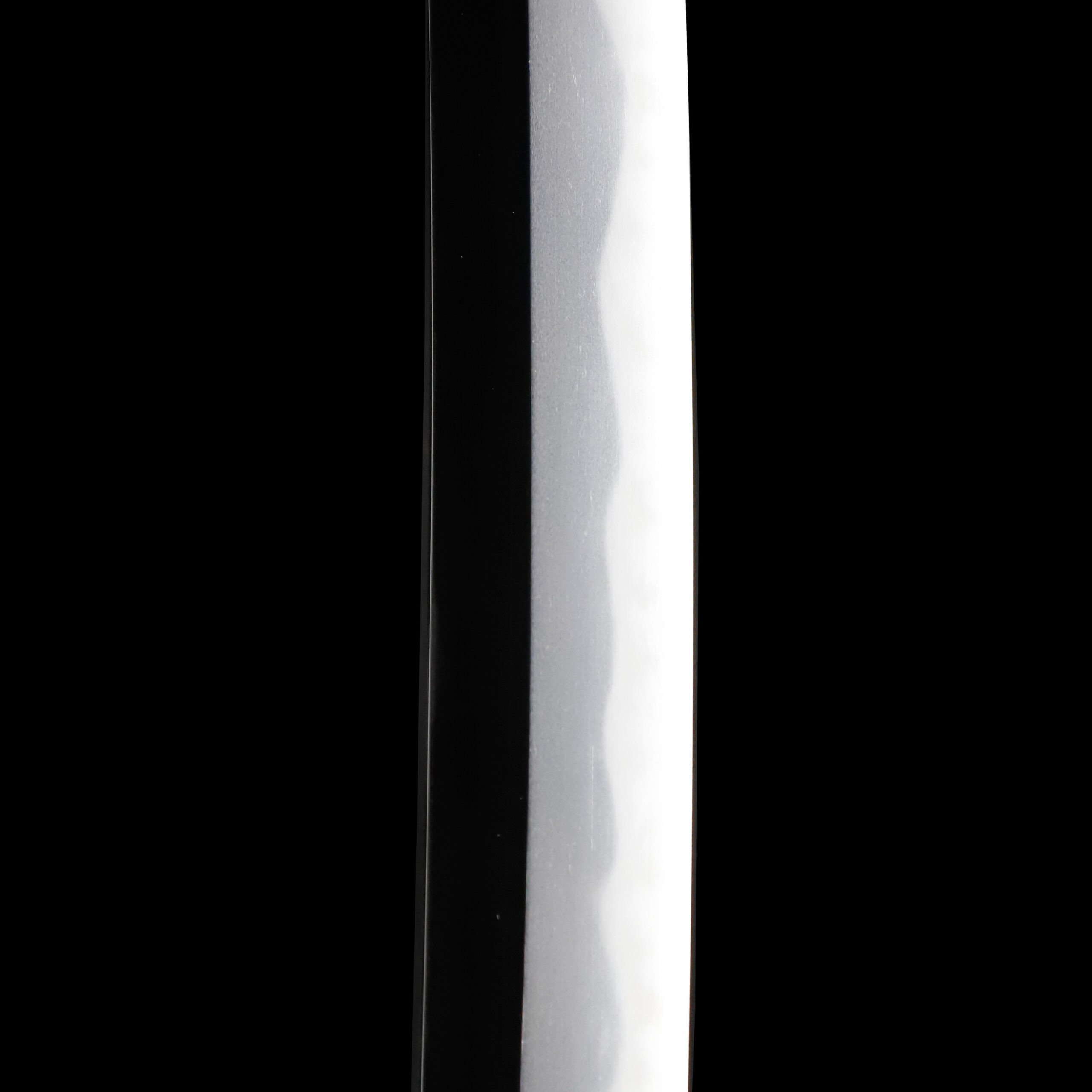
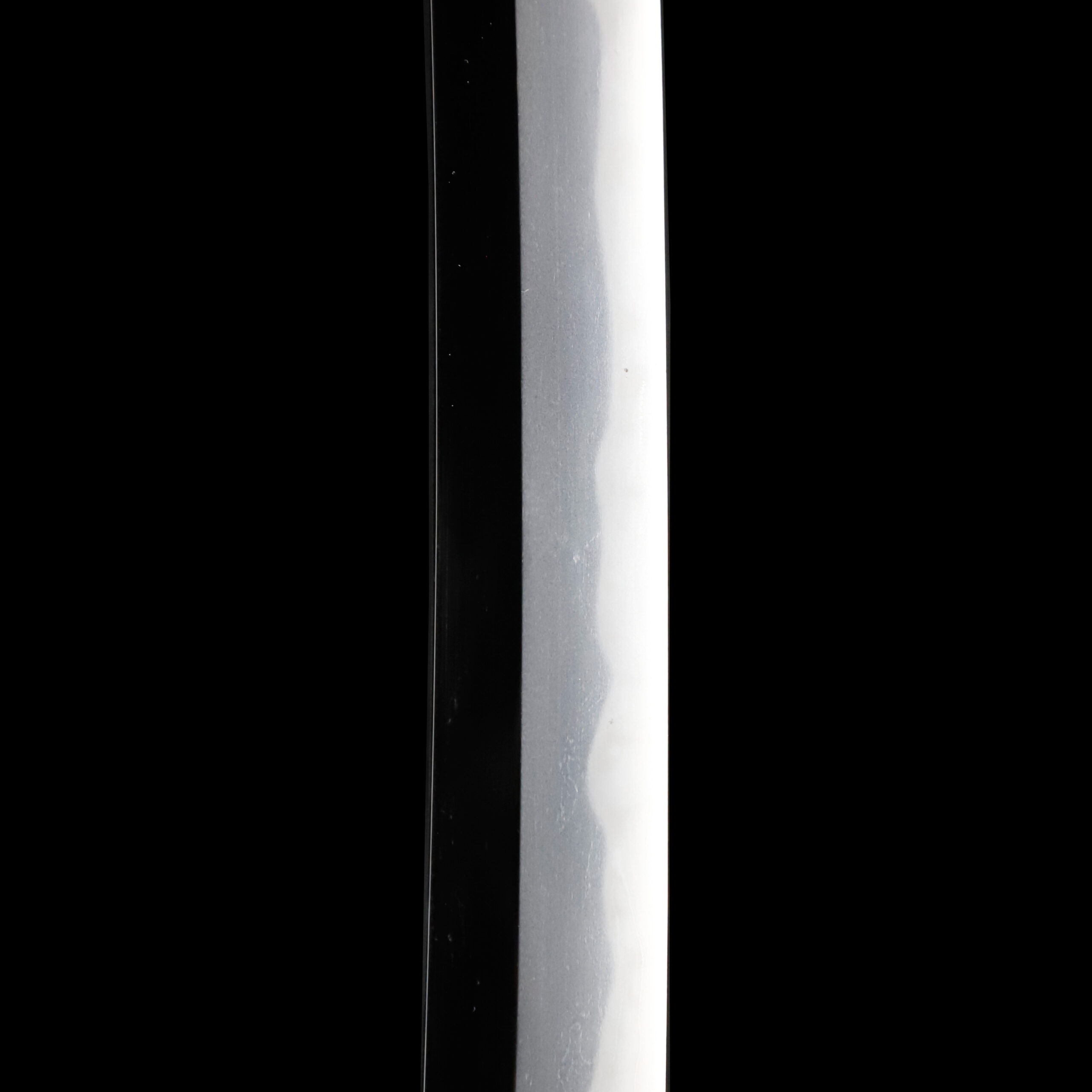
Kissaki: Kissaki is the tip of the Japanese sword.

Nakago: Nakago is the tang of the Japanese sword.
Japanese swordsmiths left the black rust on the tang because it prevents red rust while the tang is in its handle. And the discoloration of the tang was created over time, and it is a great indicator for a Japanese sword specialist to estimate when the sword was forged.
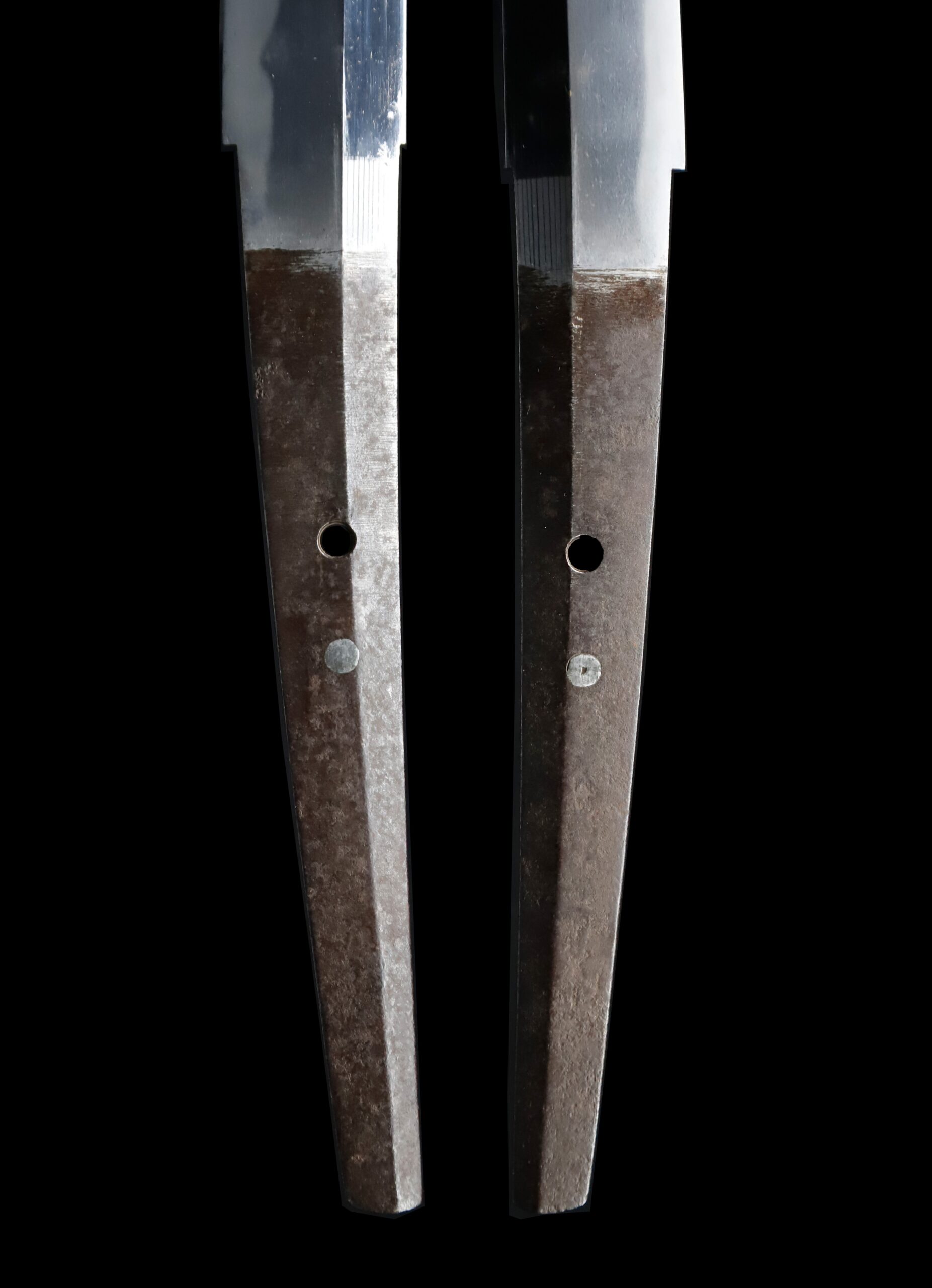
Koshirae: Koshirae is the mounting of the Japanese sword. There are several parts that consist of Koshirae such as Saya (Scabbard), Tsuka (Handle), Tsuba (Handguard).
Many sword mountings such as Tsuba, Kozuka, Kougai and the scabbard of this Koshirae are decorated with the same golden pattern: the Kuruma (車, car) pattern. The Gosho Guruma (御所車) is the origin of this design. The Gosho Guruma is a commonly used term for the Gissya (牛車, oxcart). It is said that this pattern became established as a family crest during the Kamakura period.
Some family crests derived from this pattern feature a water wheel. The Suisha (水車, water wheel) pattern is a design in which several ladles are attached to the ring. The waterwheel was developed as a familiar tool for daily life and was often used as a design for the Kosodes (小袖, a kind of traditional Japanese costume) in the Edo period. The Tsuchi (槌, hammer), similar to the Hishaku (柄杓, ladle), began to be drawn in the early Edo period. The waterwheel on which the hammers are drawn is called the Tsuchi Guruma (槌車). Since the hammer is a tool for hitting stakes, and “hit” is said Utsu (打つ) in Japanese, it is likened to the figure of Samurai hitting an enemy. Hitting the enemy is expressed as Teki-Wo Utsu (敵を討つ) in Japanese.
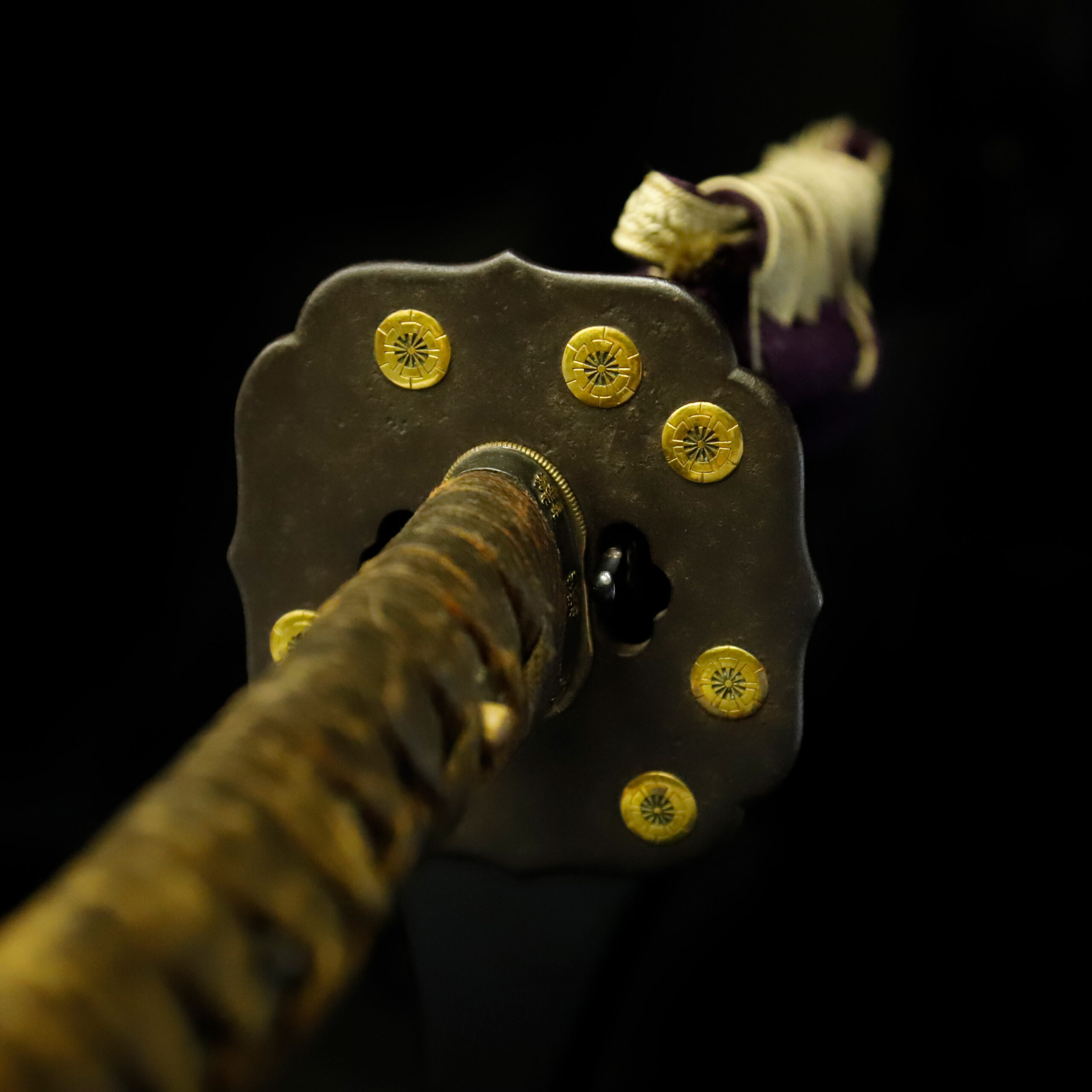
Fuchi-Kashira: A pair of matching sword fittings that cover the upper and bottom parts of its sword hilt.
Although the surface of this Fuchi Kashira has partially worn out due to aging and friction, it is decorated with the Nanako-Ji (魚子地) technique. This process makes a uniform minimal protrusions pattern by hitting the Nanako-Ji Tagane (魚子地鏨, a chisel for this technique) on a metal surface. This decorative technique is often seen on sword mountings.
About the design, this Fuchi Kashira is decorated with the common motif: the Gosan-no-Kiri Mon (五三の桐紋). It comes from the Kiri (桐, paulownia) pattern, and the Gosan-no-Kiri Mon is a popular and famous design for this flower pattern. The Kiri pattern is generally composed of three standing straight inflorescences and three leaves. The number of blooming flowers at each inflorescence means the ranks of this design. The imperial family and national leaders back then once used this plant pattern. Today, this plant pattern is used as the crest of the Japanese Government. It is permitted to be used by ordinary households and is appreciated as their family crests. According to a tradition, the Houou (鳳凰, Fenghuang, a kind of sacred beast) rests its wings at the paulownia tree; therefore, it has come to be regarded as a sacred plant. We estimate this pattern is designed here as a family crest. As mentioned above, this was a noble design that was once allowed for limited use by people of high social status.
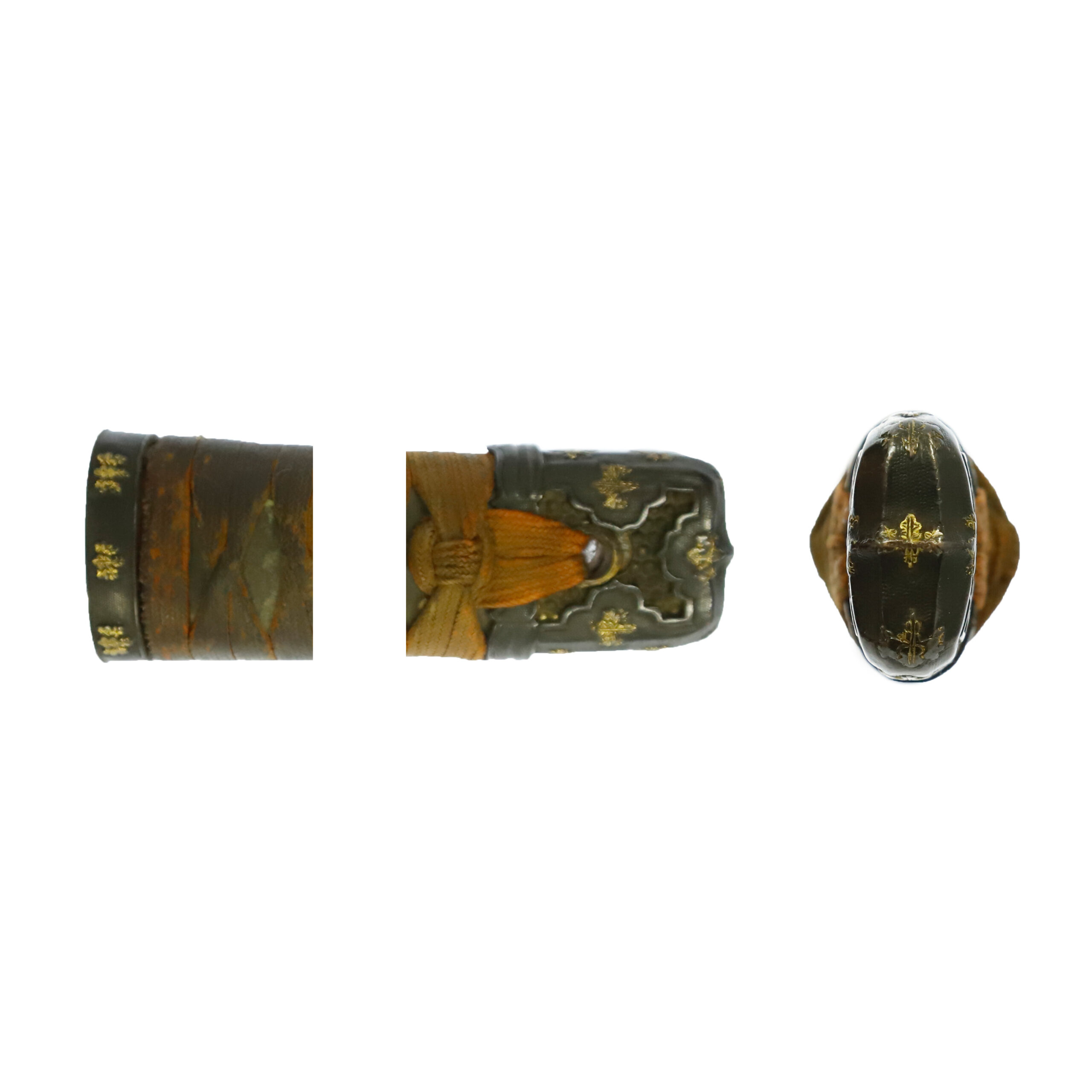
Tsuka and Menuki: Tsuka is the handle of the Japanese sword and Menuki is its decoration.
While most of the colorings have already faded due to aging, this Menuki seems to have been initially colored with golden paint. Seeing from the gaps of the Tsukamaki thread, some plants are the motifs of this Menuki. While we cannot say for sure what kinds of flowers are, we estimate these are familiar plants to Japanese people.
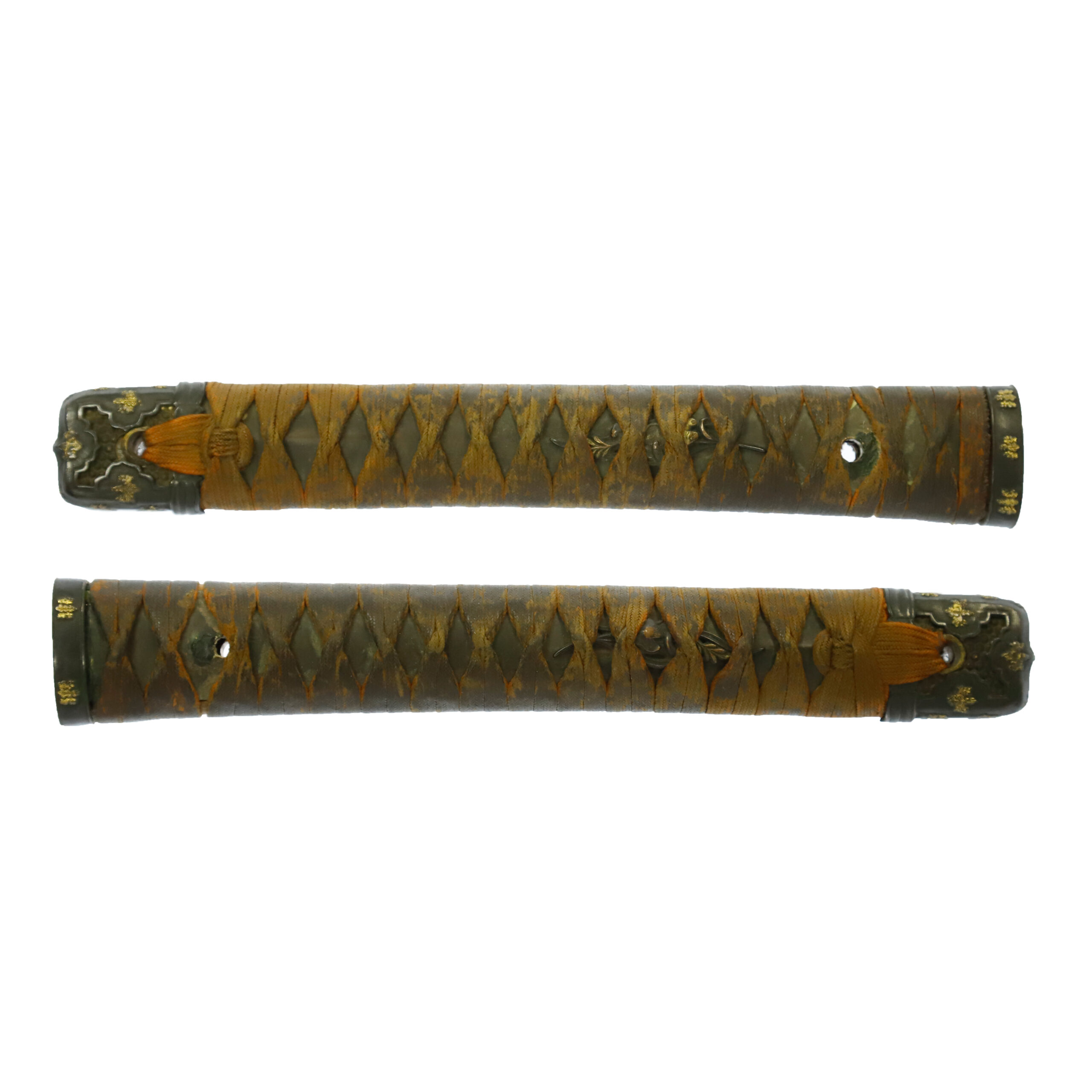
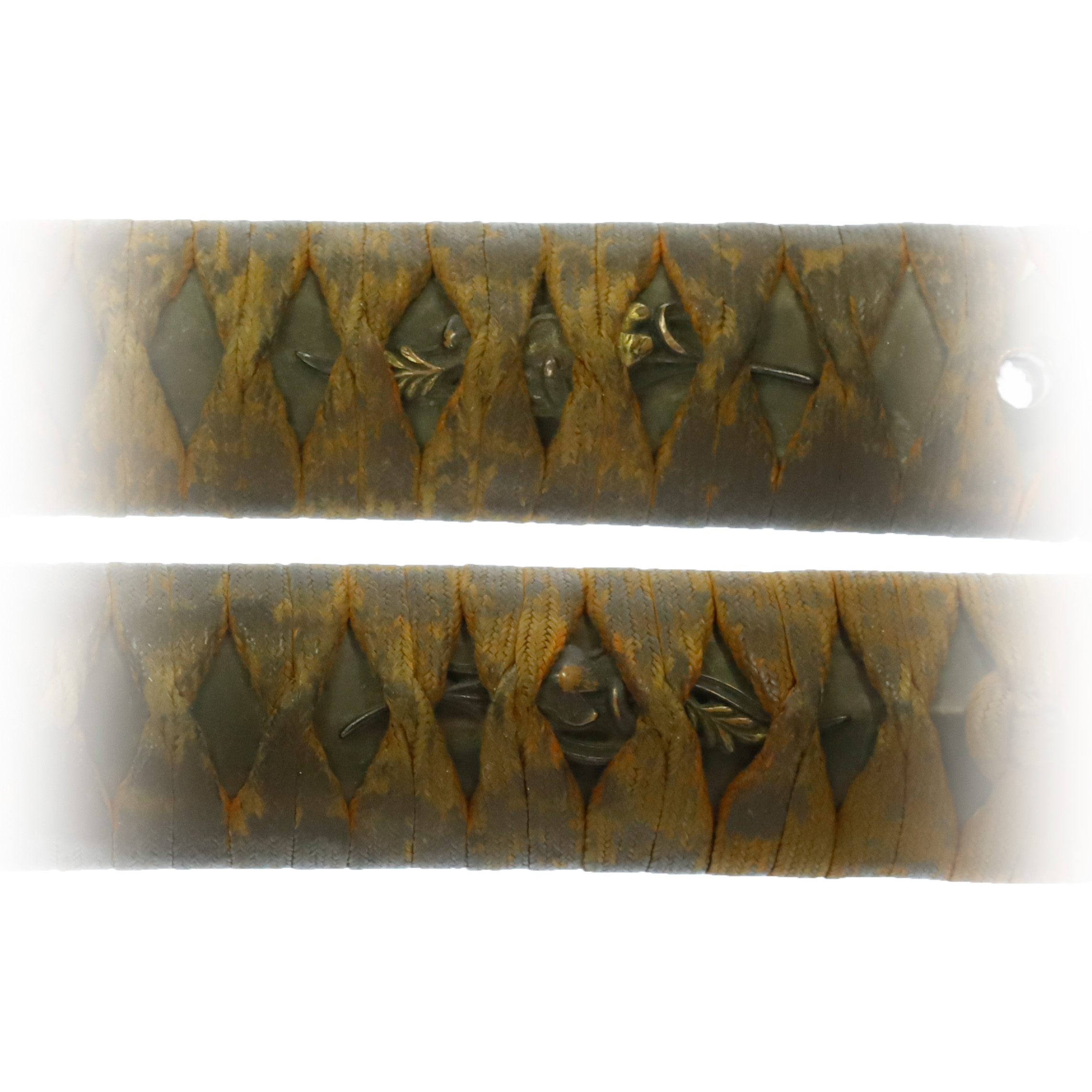
Tsuba and Habaki: Tsuba is the handguard for the Japanese Sword and Habaki is the equipment to make the blade not touch its scabbard inside. It prevents the blade from getting rusty and chipped.
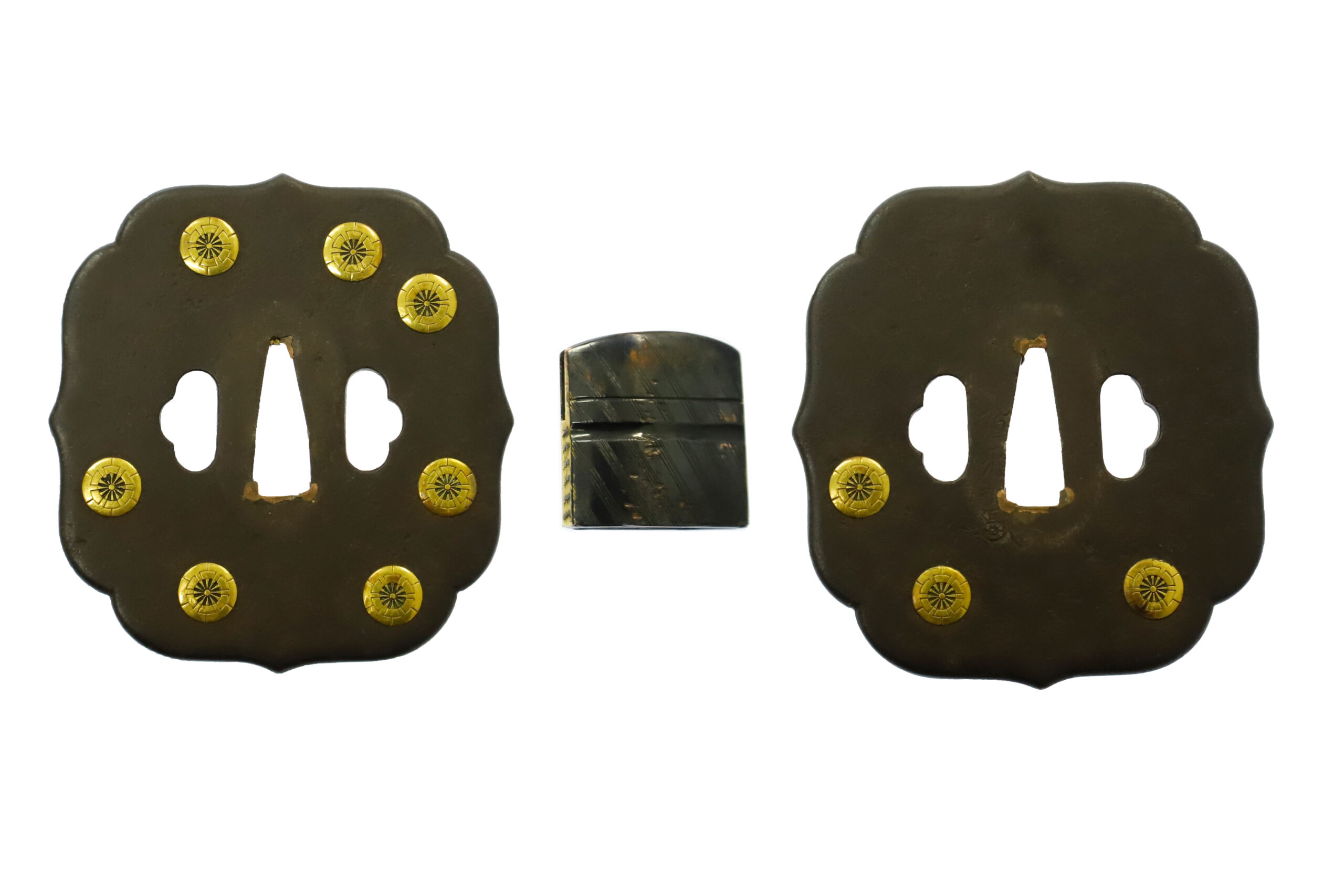
Kozuka:Kozuka is a small knife stored in Kozuka Hitsu(groove of the sheath of the Japanese sword).
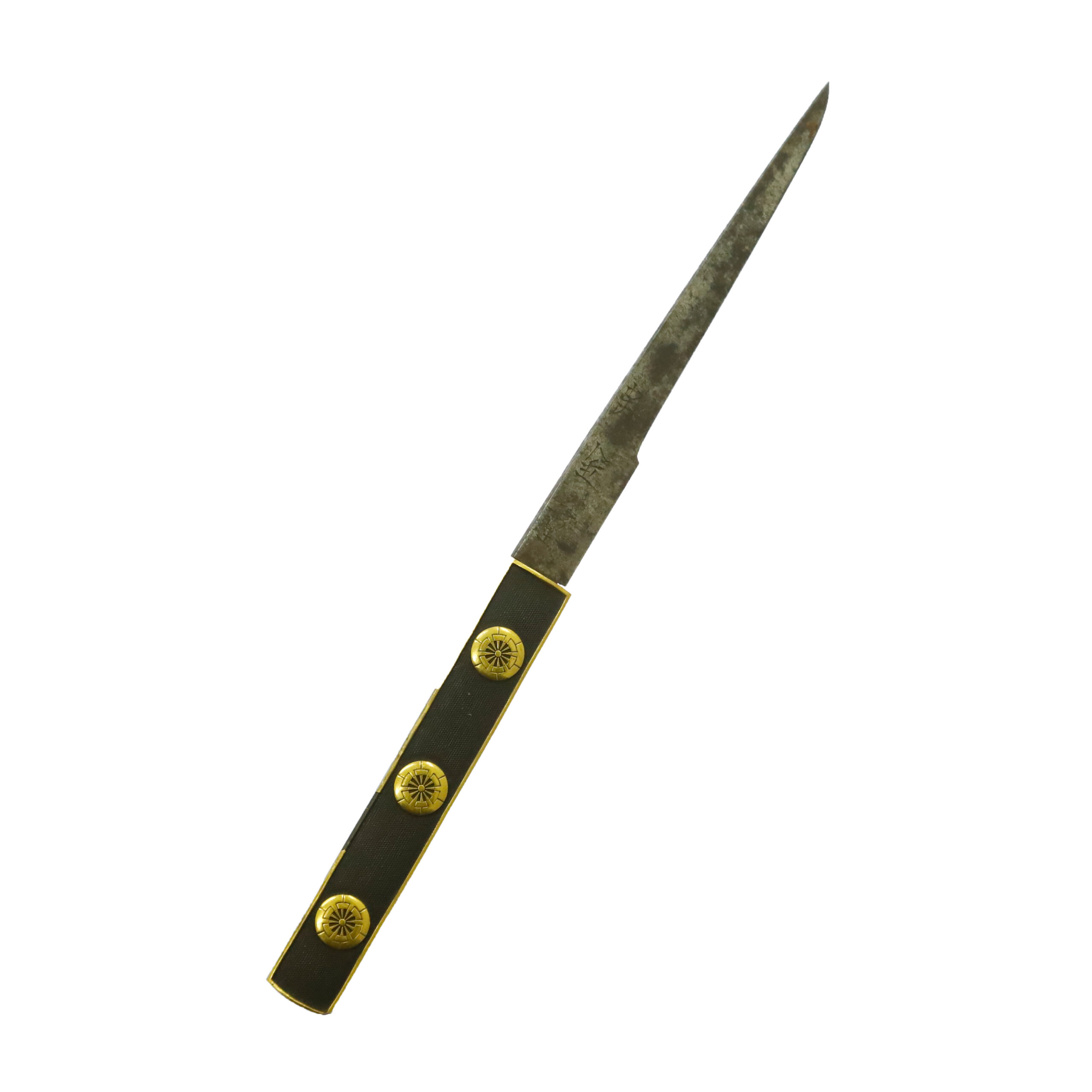
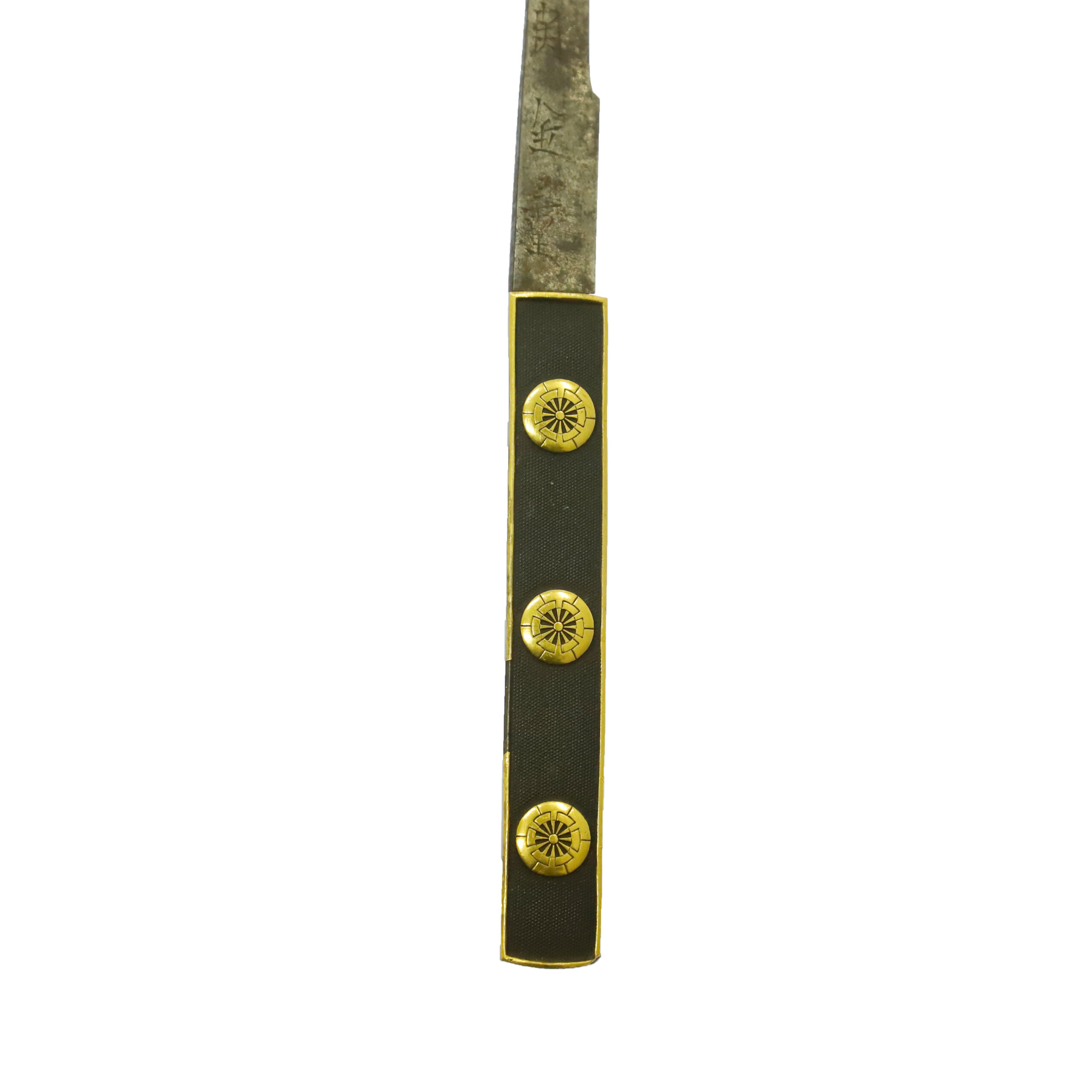
Kougai:Kougai is the equipment for Samurai to arrange or fix his hair style.
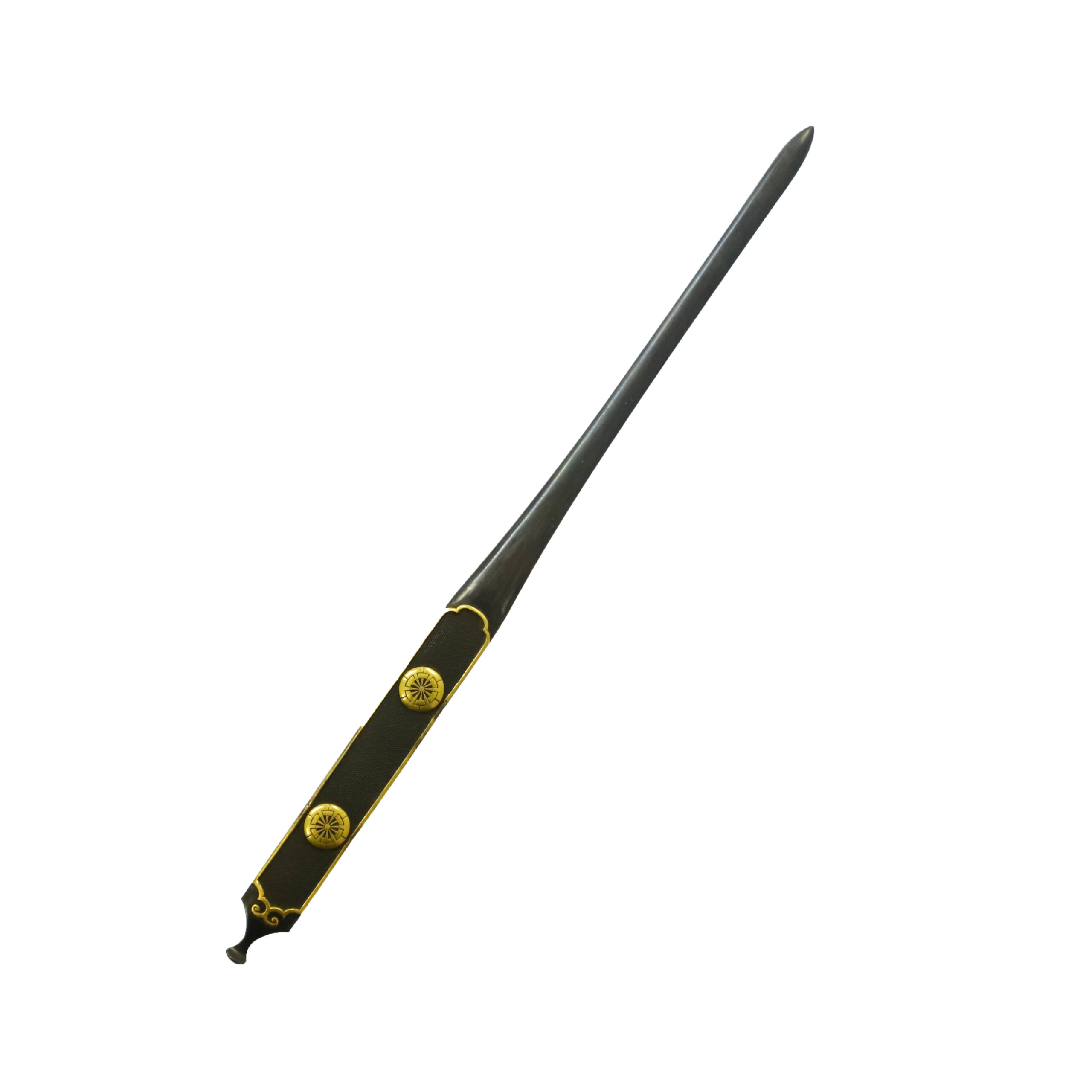
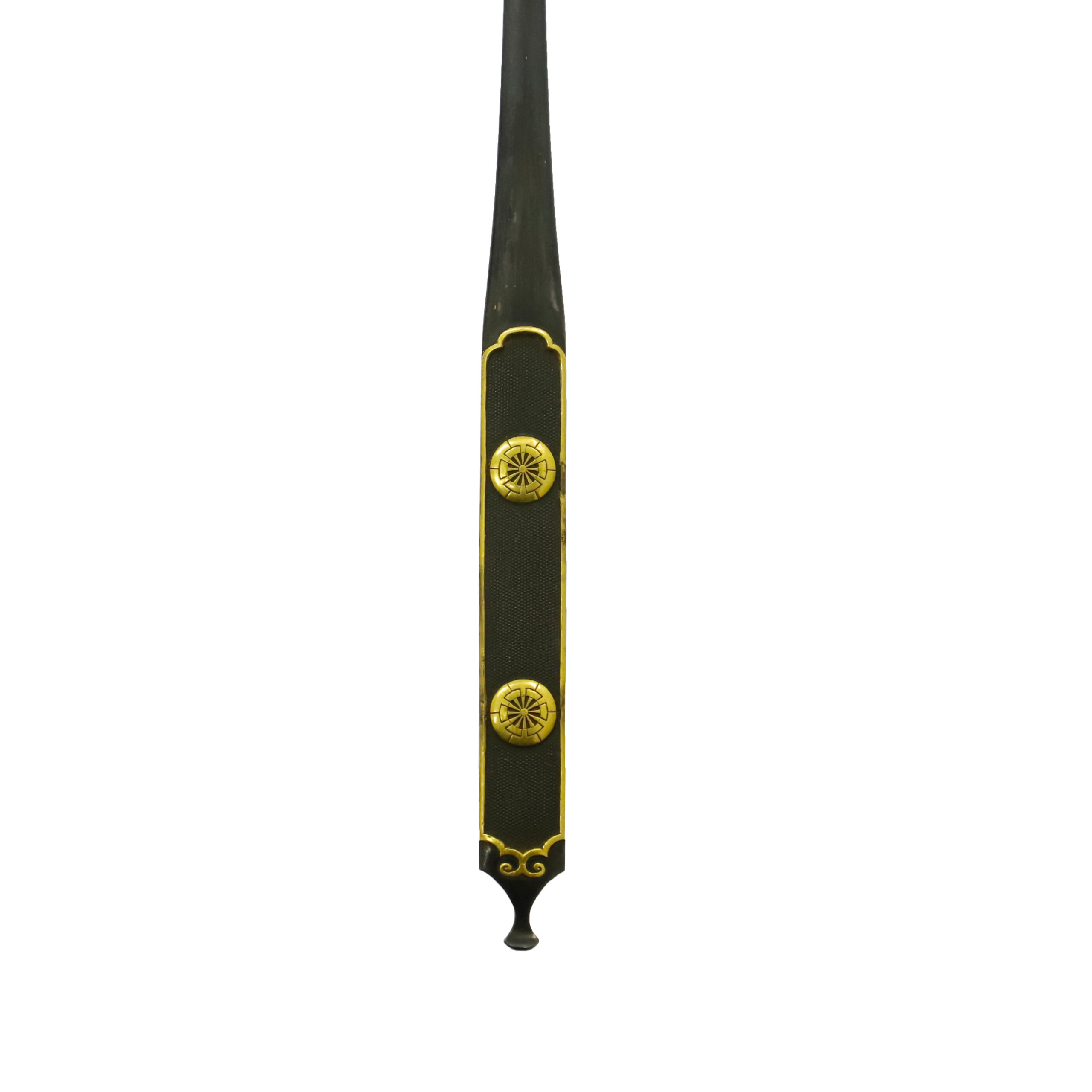
Saya: Saya is the scabbard for the Japanese sword.

Authentication Paper: NBTHK Hozon Certificate for the blade (No.3032617)
NBTHK, also known as Nihon Bijutsu Touken Hozon Kyokai (the Society for the Preservation of the Japan Art Sword), is one of the oldest Japanese sword appraising organizations in modern-day Japan. They authenticated the blade on August 25th in the 5th year of Reiwa (2023). They appraised it as Hozon Touken, the blade worth preserving for Japanese society. The purchaser will receive this original certificate as well. We can also translate what is written into English and make a PDF file for your record if you request.
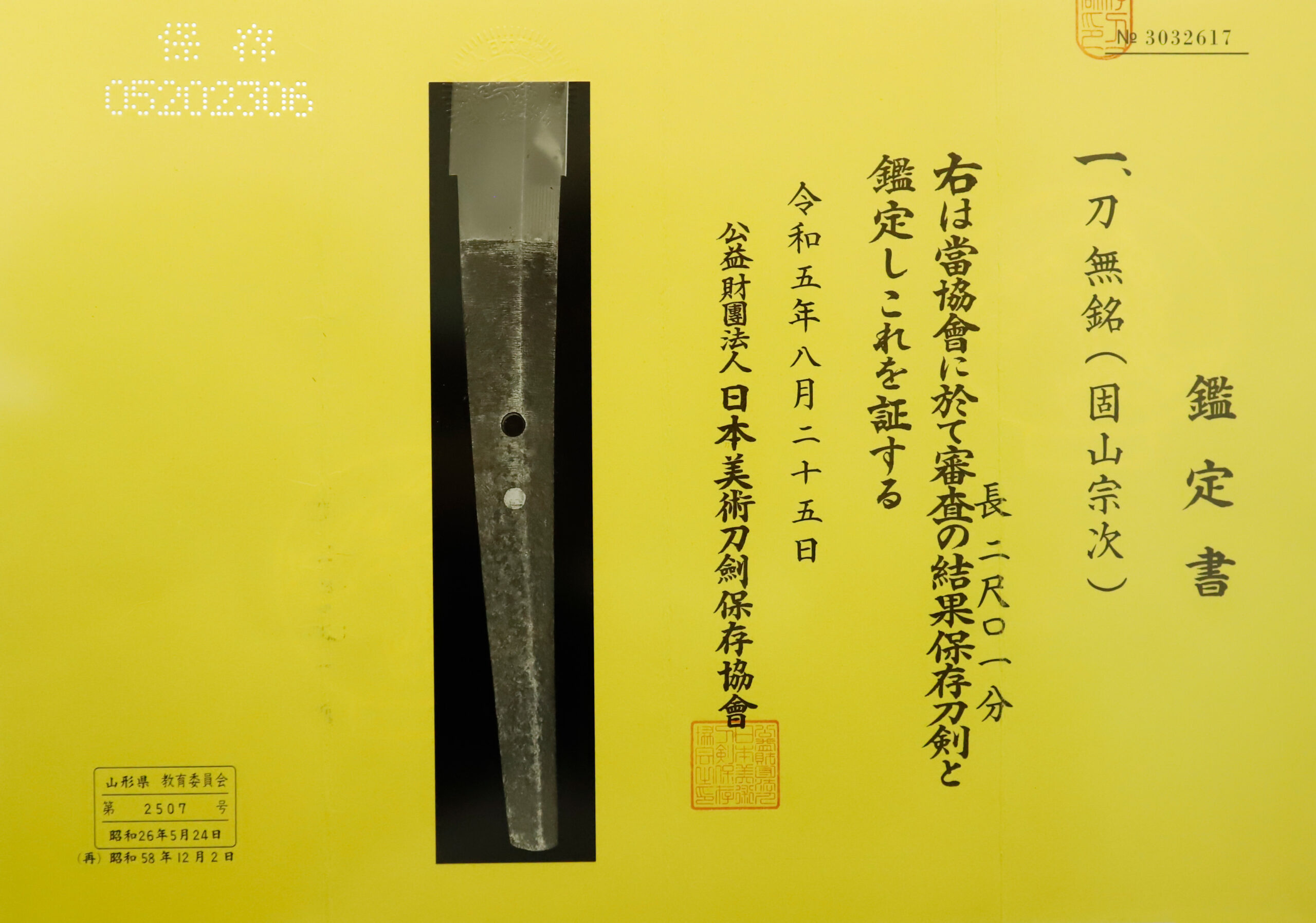
Registration Number: Yamagata 2507
The Board of Education in Yamagata prefecture issued a registration paper for this sword. It is called Jyu Token Rui Torokusho (銃刀剣類登録証). Bunkacho (The Agency for Cultural Affairs) acknowledges a Japanese sword with this paper as a work of art.
The sword needs to be traditionally hand-forged and made of Tamahagane carbon steel to be registered in the system. With this paper, its owner in Japan can legally own an authentic Japanese sword. Based on this registration number, we will apply for its export permit.
This paper will need to be returned to the board of education when the sword is being shipped abroad, but you can receive a copy of it. An English translation of this registration paper is available on request.
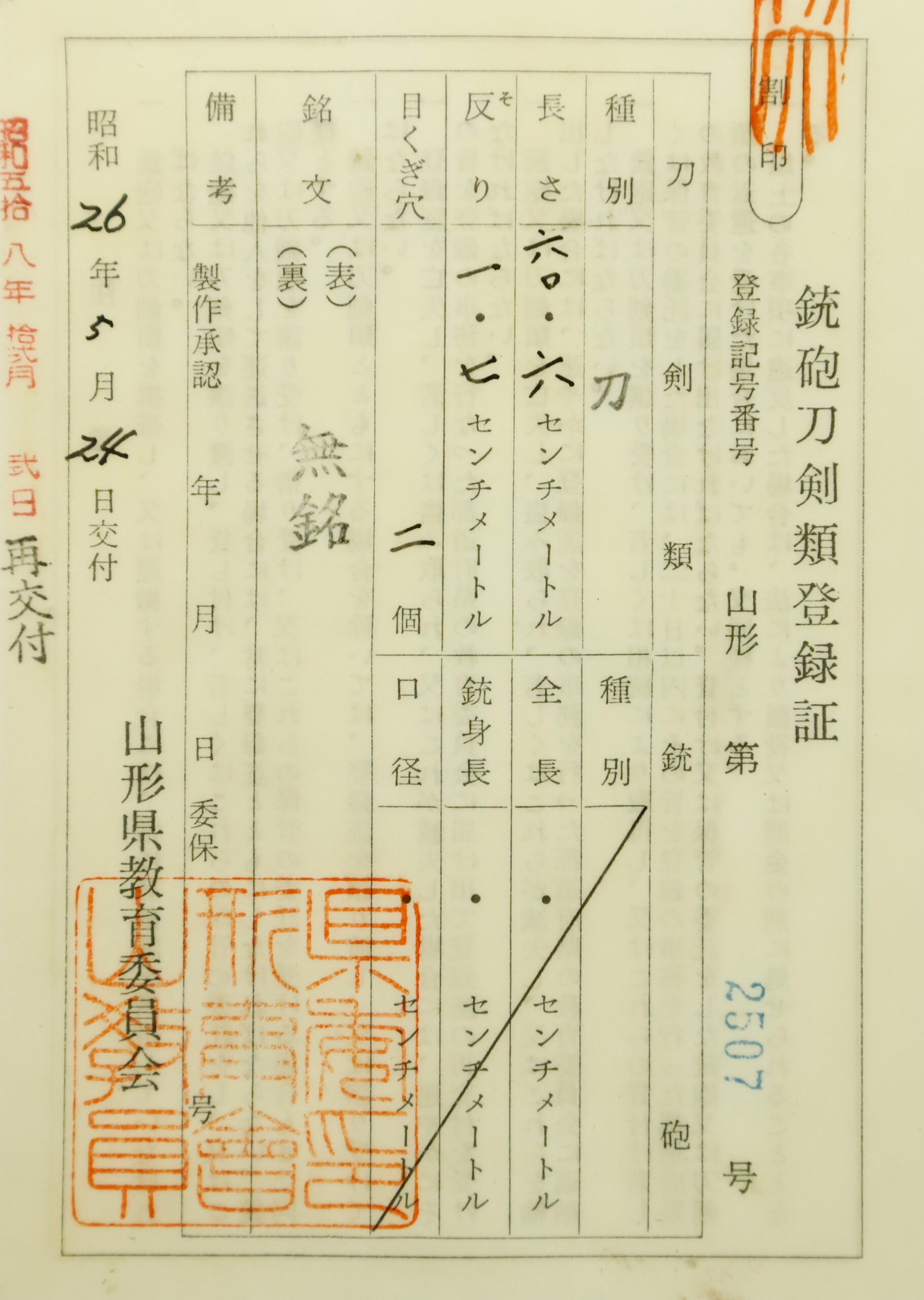
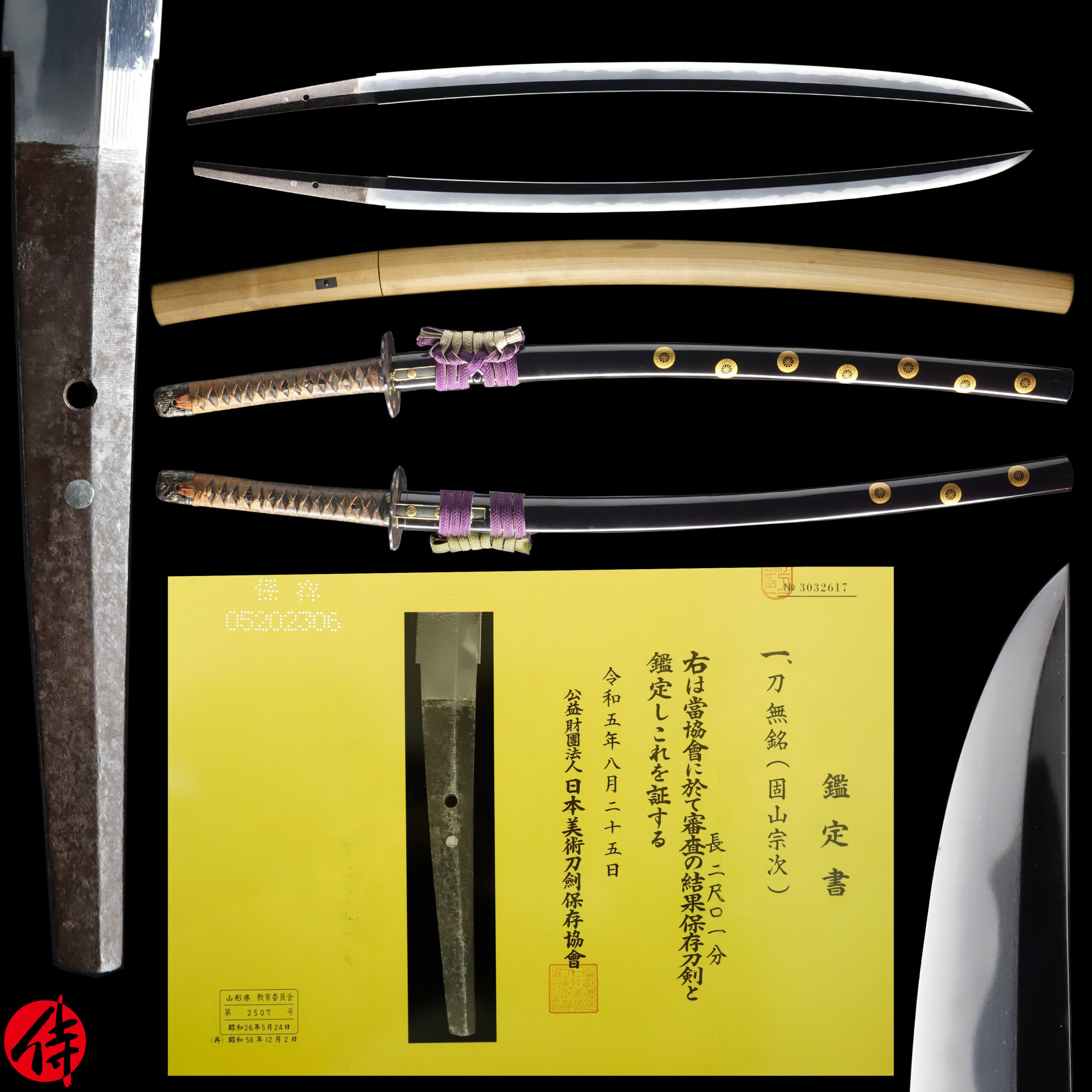
【About us】
Samurai Museum is located in Tokyo, Japan, exhibiting antique artifacts related to the Samurai history. Samurai Museum Shop is the place for those who are interested in Japanese culture and craftsmanship. We deal with antique Samurai swords/armor, traditional crafts made in Japan and so on.
【Japanese Sword& Export Process】
The Japanese swords we deal with are hand-forged edged swords made in Japan. It was made from the traditional carbon steel called TAMAHAGANE(玉鋼). Samurai Museum is familiar with the proper legal procedure for an antique/ authentic Japanese sword to be exported from Japan. We have sent more than 700 Japanese swords for the past few years (~2024) to amazing owners who appreciate its historical value.
Each Japanese sword is registered under the Agency for Cultural Affairs and the Board of Education in Japan. They issue a registration paper for each Japanese sword for its owner in Japan to legally possess it. The Japanese sword with its registration paper means it was traditionally hand-forged in Japan.
To legally export the sword from Japan to other countries, we will have to apply for its permit to the Agency for Cultural Affairs(Bunkacho) and return the original registration paper to the Board of Education. It normally takes around 2-4 weeks to receive this permit after submitting required documents. And we would like you to expect at least 1-1.5 months for your order to arrive at your given address after you ordered. For more detailed info, please click here.
It is allowed for residents in Japan to own authentic Japanese swords without a special license as long as they come with registration papers. Please feel free to contact us if you are a resident of Japan, whether temporarily or permanently. We will also assist you when you leave Japan and need to obtain the export permit.
【Payment Method】
We accept payment through Stripe (Credit card), PayPal, Apple Pay or ChromePay, all of which are secure payment methods. Also, you don’t need to make an account on Stripe for the checkout. If you prefer other payment method, please contact us. After confirming your payment, we will apply for an export permit. You may either pay in JPY, USD, AUD, CAD,EUR CHF or GBP. The price is set in Japanese Yen. Prices in other currencies are automatically calculated based on the latest exchange rate.

* If the amount is above 1 million JPY, Stripe or wire transfer will be the only options for payment.
【Shipping】
We have shipped authentic Japanese swords to the USA, UK, Canada, Mexico, Germany, France, Hong Kong, Finland and Australia. If you don’t live in these countries and like to order, please contact us first before making a purchase. We offer Free International Shipping as long as we can send antique Japanese swords by EMS.
We normally ship by EMS(Express Mail Service) provided by Japan Post. We will send you a tracking number for your order as soon as we hand it to the post office. We will put 100 % insurance on the shipping document without any extra charge. Based on the total amount, there might be a duty tax or other fee for you to pay, depending on the countries. We use package cushioning to protect the item and put it in a PVC pipe, which is one of the most secure packages because of its durability.
It will normally takes 5-14 days for the item to arrive at your given address after we dispatch it. Time of delivery is estimated as accurately as possible by the carrier but does not take into account any delays beyond our control such as by inclement weather, post office holiday seasons.
* If you live in Australia and like to purchase an authentic Japanese sword, please click here to know the detail.

【Review】
Here is one of the reviews we received from a customer who purchased an authentic Japanese sword from us. For more reviews, please click here.
“My experience overall with the whole process was wonderful. I had many questions about the history and process to purchase these treasures. All my questions were answered very timely and complete. The staff is very knowledgeable and very well versed if any questions do arise.”
【How to make sure the condition】
Please keep in mind that what you are going to purchase is an antique item. We uploaded high resolution photos for you to check its condition thoroughly. If you like to see more photos with different angles, please feel free to contact us. We will be happy to send them to you so that you can make informed decision. It is essential for us to know that you are happy with your choice of a sword. and we are prepared to use the best of our ability to serve you.
【How To Contact Us】
Please contact us through email, Facebook Messenger or Live Chat if you have any questions. You can find each icon on the right side of the website. Please click one of them to reach us. We will reply to you within 1-2 business days.
【The Art of Nihonto (Japanese Sword)】
Samurai’s history is a profound, eloquent legacy of ancient Japanese warriors in which millions of people worldwide are being fascinated. If you like to find out the art of Nihonto, please click here.
【A Guide to Japanese Sword Maintenance】
After acquiring an genuine Japanese sword, it is also important to know how to take good care of it. Here is the special video for you. Mr. Paul Martin, Japanese sword expert, shows you how to give proper maintenance to your sword. By mastering how to clean the Japanese sword, its aesthetic beauty will last forever.
When you purchase a Japanese sword from us, you can get a Free Japanese sword maintenance kit. It comes with four tools(Choji Oil, Uchiko Whetstone Powder, Peg remover, Oil Applicator). By watching the video instruction above , you can enjoy learning how to maintain your Japanese sword while appreciating it. If you have any difficulty assembling the sword or cleaning the blade, you can feel free to contact us.


MORE ANTIQUE JAPANESE SWORD FOR SALE
SWORDS WITHOUT CERTIFICATES FOR SALE
LEARN JAPANESE SWORD TERMINOLOGY
Thank you for reading all the information on the page. If you have any difficulty choosing the right Japanese sword for you, we will be more than happy to help you find the one that speaks to you the most. Please feel free to contact us.
